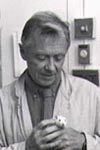Interdisciplinary Research Awards
The SPIN grant program supports interdisciplinary and collaborative research within one or more of the three target areas of the SPIN. Applications may request up to $50,000, and we anticipate awarding 3-4 grants this year. Principal investigators must be full-time tenure-track faculty members within one of the SPIBR sponsoring units at the University of Rochester.
2025 Award Recipients
Visualizing and mitigating the immune response to cell replacement therapies in the eye

 PI's: Juliette McGregor, Minsoo Kim, David Gamm
PI's: Juliette McGregor, Minsoo Kim, David Gamm
The debilitating vision loss caused by conditions like age related macular degeneration and glaucoma represents a significant burden on both the individuals affected and society as a whole. In these diseases there is progressive death of neurons at the back of the eye, which as part of the adult nervous system, cannot regenerate. Advances in life expectancy mean that the number of people living with untreatable visual impairment is therefore substantial and continuing to rise. Cell replacement therapy offers significant promise for these individual and recent developments in stem cell technology have made it possible to produce large numbers of immature retinal cells with the capacity to integrate into the diseased retina, repairing the damage. Whilst this brings the goal of regenerative therapy for vision loss within grasp, substantial hurdles remain, not least the interaction between the new cells and the patient's immune system that may jeopardize the survival and integration of the transplant.
We propose leveraging a newly developed technique to visualize retinal immune activity at the cellular scale in the living eye following cell replacement therapy. We will characterize the time course and nature of the immune response in an animal model of vison loss while simultaneously tracking the survival of the transplanted cells. The results of this pilot study will enable 1.) The development of effective strategies to mitigate the immune response and prevent transplant rejection while minimizing or eliminating harmful side effects from immune suppressant drugs 2.) The development of label free imaging biomarkers for transplant rejection in the eye that can be used monitor patients receiving cell therapy.
PPP2R5D human de novo mutations, increased neuronal excitability, and maladaptive callosal myelination

 PI's: Houhui Xia, Ania Majewska
PI's: Houhui Xia, Ania Majewska
Whole exome sequencing, a new technology of sequencing the gene-coding portion of human genome, can diagnose the genetic basis of intellectual developmental disorder (IDD) in patients whose parents are neurotypical. PPP2R5D is one of the genes mutated in IDD patients who also have epilepsy. E198K and E420K are among the most prevalent mutations in PPP2R5D that lead to severe symptoms, but how these mutations affect the function of PPP2R5D leading to brain changes that result in symptoms in patients is still unknown. Even though 198 position is far away from 420 position on PPP2R5D primary sequence, they are very close on PPP2R5D 3-D structure, consistent with similar symptoms in human patients with these two mutations.
We are using transgenic knockin (KI) mouse models, whereby these two mutations are introduced into the mouse genome, to study the roles E198K and E420K play on brain function with an emphasis on the mutation effect in molecules important for neuronal function. We have found that E198K and E420K increase the excitability of neurons which could explain both the presence of IDD symptoms as well as the accompanying seizures. Here, we will build on our preliminary data to investigate whether molecular mechanisms that alter chloride concentrations in neurons are the link between these PPP2R5D mutations and neuronal excitability. Furthermore, we will investigate how altered excitability in our mutants affects myelination, which is important for proper network activity and which is exquisitely sensitive to neuronal activity. Our work will provide insight on novel therapeutic targets based on chloride homeostasis and activity-dependent myelination in treating neurological symptoms in human patients.
Investigating the Differential Effects of Repetitive Transcranial Magnetic Stimulation (rTMS) on Left and Right Motor Cortex in Fibromyalgia: A Prospective Randomized Trial with Functional MRI

 PI's: Paul Geha, Bekir Nihat Dogrul, Oner Gonen, Jennifer Gewandter
PI's: Paul Geha, Bekir Nihat Dogrul, Oner Gonen, Jennifer Gewandter
Fibromyalgia is a chronic pain condition that impacts the quality of life, causing fatigue, sleep disturbances, and mood symptoms such as depression. Current treatments often provide limited relief due to the multifactorial nature of fibromyalgia. Repetitive Transcranial Magnetic Stimulation (rTMS) is a promising, non-invasive therapy that uses magnetic pulses to modulate brain areas involved in pain processing or emotion modulation. It has no systemic side effects and does not require anesthesia. In our study, we aim to modulate the motor cortex in participants with fibromyalgia using rTMS. The motor cortex is a well-known target for pain relief, and most studies have investigated the left motor cortex, as it is the dominant side for most people. However, emerging evidence suggests that the right motor cortex may also play a role in chronic pain. No study has yet examined whether targeting the left or right motor cortex leads to different pain-relieving effects in fibromyalgia. We will recruit 20 volunteer participants with fibromyalgia, who will undergo functional magnetic resonance imaging (fMRI) before starting rTMS treatment to establish a baseline of brain functional connectivity. Then, we will randomly assign 10 participants to receive rTMS treatment on the right motor cortex and 10 on the left motor cortex over two weeks, followed by a second fMRI to compare the functional changes. Pain levels and quality of life will be evaluated before and after the treatment. By comparing the effects of rTMS, we aim to investigate how brain connectivity changes in response to rTMS, explore differences between left- and right-sided rTMS treatment, and how this can guide us to use TMS as an option for fibromyalgia. This trial may help clarify the role of the right motor cortex in chronic pain and support more extensive clinical trials on fibromyalgia.
Role of MIX23 in the Mitochondria
 PI: Jenetta Hammond
PI: Jenetta Hammond
Mitochondria play a crucial role in maintaining cellular health by producing energy, regulating calcium levels, and controlling nutrient metabolism. The protein quality control systems of the mitochondria ensure all these functions run smoothly and at the appropriate times. Disruptions in these processes can lead to severe neurological diseases. This research focuses on a little-known mitochondrial protein called MIX23, which appears to be vital for proper mitochondrial energy production. We have discovered that a small deletion in the Mix23 gene causes significant motor impairments in mice, similar to symptoms observed in a human family with intellectual disabilities and movement disorders. We believe that MIX23 stabilizes and aids a group of proteins (specifically the prohibitins and m-AAA protease complex) that are essential for protein quality control and the assembly of the OXPHOS complexes responsible for energy production within mitochondria. Without MIX23, these processes are disrupted, leading to mitochondrial damage and neurological pathology. To investigate this, we will examine the interaction of MIX23 with proteins in the prohibitins and m-AAA protease complex and assess how the absence of MIX23 affects the composition of this complex and its ability to assemble the OXPHOS complexes. We will additionally investigate how the loss of MIX23 affects mitochondrial properties such as energy production, size, and stress responses. This research is innovative because it is the first to explore the molecular functions of MIX23. By understanding how MIX23 contributes to mitochondrial processes, we will better understand how genetic variants of MIX23 lead to intellectual disabilities and movement disorders. This knowledge could improve diagnostic capabilities and genetic counseling, and potentially lead to the development of new therapies for neurodegenerative diseases where mitochondrial dysfunction is a key factor.
Prior years award recipients
Neural Mechanisms for Coordinating Selective Processing of External and Internal Information
 PI: Ian Fiebelkorn
PI: Ian Fiebelkorn
Funding Source: The Schmitt Program in Integrative Neuroscience
Imagine meeting a friend in a busy city-scape, like Times Square in New York City. This complex environment provides a flood of information, from which the brain has to select the most important information for preferential processing. While navigating through pedestrians, etc., the brain must also select the most important information from its internally stored memories, such as the specific street corner where you agreed to meet your friend. That is, everyday tasks typically require selective processing of both external information and internally stored information. Here, we will determine how the brain accomplishes such multitasking, by flexibly balancing these complementary but potentially competing processes. We will compare neural data across tasks that require either external sampling, internal sampling, or both. Our findings will reveal (i) whether these sampling processes can occur simultaneously, or instead, (ii) whether these sampling processes alternate in time, perhaps on a sub-second time scale (e.g., four times per second). Our findings will also reveal the extent to which external and internal sampling rely on the same or different neural resources, and on how those neural resources change depending on task demands (i.e., whether the task requires external sampling, internal sampling, or both). The proposed work will thus provide critical insight into how the brain accomplishes multitasking and maintains cognitive flexibility, potentially leading to new hypotheses regarding possible dysfunctions and treatments in brain disorders associated with deficits in cognitive flexibility, such as attention deficit hyperactivity disorder (ADHD) and obsessive-compulsive disorder (OCD).
Vestibular Cross-Talk: Does Adapting Gaze Stability Pathways Modify Other Vestibular Pathways
 PI: Eric Anson
PI: Eric Anson
Funding Source: The Schmitt Program in Integrative Neuroscience
The inner ear has both gravity sensors and head rotation sensors that help with balance and gaze stability (seeing clearly during head movement). The current approach to treating dizziness/vertigo from inner ear balance disease primarily addresses problems within the gaze stability pathway, the process that allows us to see clearly during head movements. However, there are some inner ear balance diseases for which beneficial exercises have not been identified. Our goal is to address this knowledge gap to ultimately improve patient care. It is unclear whether gaze stabilization improvement will also be helpful for problems with gravitational reflexes/perceptual pathways in the inner ear that help humans balance. Performing exercises that modify the gaze stability system in healthy adults immediately worsens balance. This suggests our understanding of the neurological pathways impacted by gaze stabilization exercises is incomplete, and for some individuals performing those exercises may lead to increased risk for falling.
Recent work suggests that balance problems from inner ear balance diseases are caused by inconsistency and variability in the neural pathways from the inner ear to the brain/muscles. We will compare two methods which adapt inner ear reflexes in healthy adults to improve our understanding of the neurological pathways impacted by gaze stabilization exercises. Our methods will test both reflex behaviors and perception of gravity, expanding current understanding of the neural pathways influenced by gaze stability exercises.
Neurophysiological mechanisms of visual perception abilities in neurotypical development and children with autism spectrum disorder Our methods will test both reflex behaviors and perception of gravity, expanding current understanding of the neural pathways influenced by gaze stability exercises.
Dr. Anson and his team will conduct a series of experiments examining changes within neurological pathways caused by gaze stability exercises to better understand safe exercise design and prescription for persons with dizziness. This proposal is significant because the mechanisms of unintended adverse body sway after gaze stabilization exercises may increase fall risk for individuals with dizziness or imbalance. Knowledge from this proposal will influence personalized exercise prescription for individuals with dizziness.
Feeding stress forward through DA Circuitry

 PI's: Julie Fudge, Emily Kelly
PI's: Julie Fudge, Emily Kelly
Funding Source: The Schmitt Program in Integrative Neuroscience
Chronic stress is associated with symptom exacerbation in many psychiatric illnesses, and is well known to alter the brain's dopamine system. The mechanism by which stress stimulates brain changes and makes the brain more 'sensitive' to stress is not known. Our lack of knowledge is due to many factors, including an incomplete understanding of stress circuitry, experiments that are too 'short-lived' to examine long-term brain changes, and animal models that do not resemble the human in important ways. This proposal examines whether overexpressing a classic stress peptide (corticotropin releasing factor, CRF) in specific circuitry of the macaque can provoke lasting structural (synaptic) changes in brain connections specifically involving DA neurons. We further hypothesize that these synaptic changes will correlate with increased anxiety and neuroimaging findings in these animals.
A noninvasive method to study dynamics of cell-class specific circuits across widespread brain networks of non-human primates



 PI: Manuel Gomez-Ramirez, Jude Mitchell, Marvin Doyley, Kuan Hong Wang
PI: Manuel Gomez-Ramirez, Jude Mitchell, Marvin Doyley, Kuan Hong Wang
Funding Source: The Schmitt Program in Integrative Neuroscience
Complex naturalistic behavior (e.g., cooperative behavior, social cognition, and others) is a hallmark of humans and non-human primates. In particular, marmosets are a highly social species who often engage in cooperative behaviors such as grooming, foraging, food sharing, and others. As such, the marmoset is an excellent animal model to study neural circuits underlying naturalistic behavior, especially those exhibited by humans. Although much is known about the different cognitive strategies that marmosets employ to solve complex behaviors, very little is known about the neural mechanisms that facilitate these cognitive plans. Detailed understanding of the network mechanisms that support these complex behaviors require selective manipulation of the different nodes within the network. Unfortunately, we have a limited toolkit to study these mechanisms, especially in animals performing complex behaviors in their natural habitat. Thus, the overarching goal of this proposal is to develop a noninvasive neuroimaging and neuromodulation approach to study network dynamics that support complex naturalistic behavior in marmosets. In Aim 1, we establish the BioLuminescent-OptoGenetics (BL-OG) method in marmosets. BL-OG is a noninvasive method that uses internally-generated bioluminescence to generate neuromodulation effects in the brain through optogenetic mechanisms. In Aim 2, we combine BL-OG and focused ultrasound to establish a method that provides brain-site specific modulation of neural circuits in the brain in a noninvasive manner. The outcome of this work will provide critical insight to develop a noninvasive method for mapping interconnected widespread networks that support naturalistic behavior. In particular, our method is well suited to study network dynamics in marmosets engaged in complex behavior (e.g., social behavior) in their natural environment. As such, researchers can gain fundamental insight into the neural mechanisms that support social cognition in healthy-normal individuals, but also individuals with developmental disorders (e.g., Autism).
AAV-tERBB2 mediated gene therapy for cochlear regeneration

 PI's: Patricia White, Dorota Piekna-Przybylska
PI's: Patricia White, Dorota Piekna-Przybylska
Funding Source: The Schmitt Program in Integrative Neuroscience
We seek to construct and test a new gene therapy to treat adult hearing loss. Hearing loss is permanent because the cells that detect sound, called hair cells, are not regenerated if they die. This is only true for adult mammals, as birds naturally regenerate lost auditory hair cells from adjacent supporting cells. Regeneration involves the formation of new hair cells from supporting cells, as well as supporting cell mitosis. We are focused on driving supporting cell mitosis, which we previously found requires signaling from a receptor expressed by supporting cells, called ERBB2. For young mice, activating ERBB2 signaling drives supporting cell proliferation. For adult mice, ERBB2 signaling also drives expression of another signaling molecule, SPP1. We will use these findings to test a new gene therapy based on ERBB2 called tERBB2. tERBB2 requires the binding of an exogenous molecule for dimerization and signaling, which is a first for inner ear gene therapy. tERBB2 has a tag for monitoring its expression, and we further know that it induces a secondary signal from a protein called PI3K. We have already constructed and tested tERBB2 in cell culture. In our first Aim, we will make a AAV virus with tERBB2 and inject it into newborn mice. We will compare viral constructs with and without the dimerization domain, and use PI3K activation and supporting cell mitosis as read-out measures. We will test different doses of virus and different schedules of exogenous molecule injection to find the procedure that best promotes proliferation. In the second aim, we will also inject different amounts of virus into young adult mice and test for tERBB2 activation. Here our read-outs will be expression, PI3K activation, and SPP1 induction. If successful, these aims will be the first steps towards a gene therapy for treating adult hearing loss.
A Novel Functional Connectivity Biomarker for Enhancing Clinical Prediction in Early Psychosis
 PI: Julian Meeks
PI: Julian Meeks
Funding Source: The Schmitt Program in Integrative Neuroscience
Early sensory experience powerfully influences neural circuit development in sensory systems, shaping animals' lifetime capacity to navigate the world. This is well-established in visual and auditory sensory systems, but poorly understood in the chemical senses (smell, taste, etc.). Interactions between developing animals and parents critically includes chemosensation, including cues detected by the accessory olfactory system (AOS), best known for detecting and processing social odors. Social chemosignals are known to influence multiple social behaviors, but it is not known whether early life exposure to parental chemosignals influences AOS function in adulthood. We propose to study AOS plasticity in different early life chemosensory conditions (absence or presence of a father in the postnatal period), and will use physiological assays to determine whether chemosensory function in in the nose and brain depends on early life experience.
Neurophysiological mechanisms of visual perception abilities in neurotypical development and children with autism spectrum disorder

 PI's: Kerry O'banion, Ania Majewska
PI's: Kerry O'banion, Ania Majewska
Funding Source: The Schmitt Program in Integrative Neuroscience and donations from the URMC Wine Auction for Alzheimer’s Research
Currently, 6.7 million individuals in the United States suffer from Alzheimer's disease (AD); approximately 4 million are women. Many different risk factors have been identified for AD including age, sex, and gene inheritance. Related to this pilot proposal, women with AD have greater rates of cognitive decline, brain shrinkage and pathological changes compared to men. Sex differences have also been identified in many mouse models of AD where pathology and behavioral performance are worse in females. Microglia, the primary immune cells found in the brain, are strongly implicated in AD. Microglia exhibit substantial sex differences in their numbers, their responses to injury, and in the genes that they express. Although sex-dependent differences in microglia have been demonstrated in AD mouse models, the contributions of microglia to the establishment of sex differences in AD is largely unexplored. We hypothesize that microglia possess sex-intrinsic properties that drive the differences in their functional responses to Alzheimer's disease pathology. To address this question, we propose two sets of experiments. In the first, we will confirm sex differences in AD pathology and microglia in a well-established mouse model of AD. In the second set of experiments, we will transplant microglia from male mouse brain into female mouse brains (and vice versa) prior to the onset of AD pathology. After sufficient time for pathology to develop, we see if the sex of the transplanted microglia modifies AD pathology. We will also confirm that transplanted microglia retain characteristics associated with their sex of origin. To our knowledge, no other study has sought test whether microglia directly contribute to sex differences in AD. If they do, this work will support further studies aimed at determining whether properties related to sex differences might form the basis of novel therapies for this devastating disease.
Elucidating Mechanisms and Novel Therapeutic Candidates for TANGO2 Deficiency Disorder
 PI: Samuel Mackenzie
PI: Samuel Mackenzie
Funding Source: The Schmitt Program in Integrative Neuroscience
Lipids are critical components of all living cells. In some disease states, however, certain types of lipids may occur in too high or too low quantities, leading to dysfunction within the cell. We call this process "lipotoxicity," but why lipotoxicity occurs is not always well understood. Lipotoxicity has the potential to cause a range of problems including severe neurological impairment. In this study, we seek to understand how and why lipids may be unbalanced in a rare pediatric neurodegenerative disease known as TANGO2 deficiency disorder (TDD). In our first aim, we will use worms that have misspellings in their genetic code similar to human patients to discern how these misspellings and exposure to various forms of stress change behavior and survival in a worm model of TDD. We will also examine the number and shape of worms' neurons after stress and discern how mitochondrial size and number might correlate with these changes. In our second aim, we will look to see what types of lipids are higher or lower in quantity after certain stress conditions and what genes might be up- or down-regulated. We will give some worms vitamin B5 and see how this impacts survival, behavior, neuronal integrity, and lipid-gene profiles after stress. Based on data from fruit flies and even some early data from patients, we expect that this vitamin might be beneficial in TDD. Finally, in our third aim, we will conduct a high-throughput drug screen in our nematode model of TDD to see if we can identify any compounds that may rescue the worms' function. Putting all of these data together, we will try to identify key metabolic pathways in the cell that could be dysregulated in TDD. We also hope to identify promising compounds that may some day help people with this condition.
Reopening mesofrontal dopaminergic circuit plasticity in adulthood: mechanisms and therapeutic potentials

 PI's: Kuan Hong Wang, Rianne Stowell
PI's: Kuan Hong Wang, Rianne Stowell
Funding Source: The Schmitt Program in Integrative Neuroscience
Many neurodevelopmental disorders, such as Autism Spectrum Disorder and schizophrenia, have poorly understood pathology. Recent advances in biomedical research efforts have provided new avenues for targeting disease progression. Neuroscientific research has identified adolescence as a critical period where key neurotransmitter systems are still developing, offering an important therapeutic window for interventions in psychiatric disorders. Previous work in our lab and others points to increased adolescent plasticity in dopamine signaling. Dopamine is a critical neurotransmitter which impacts reward, motivation, and cognitive processing. The protracted development of dopamine circuits in the brain aligns with the timeline of psychiatric disease progression, offering us an important disease relevant developmental process to target. Our research seeks to understand how dopamine circuit plasticity during development occurs within the brain. While neurons are the key cellular building block in brain circuits, we have also found that other cells, such as the immune cells of the brain, influence adolescent circuit malleability. Our prior work has also found that stimulating adolescent dopaminergic plasticity can remedy neurodevelopmental disorders in animal models. We are now furthering our investigation with two research aims designed to evaluate both the mechanisms of reopening dopaminergic plasticity in adult animals, and the therapeutic potential of reopening plasticity. The first aim will determine if innate immune cell interactions with neurons in the frontal cortex are necessary for reopening adult plasticity. The second aim will assay if reopening plasticity by combining antipsychotic and wheel running will rescue deficits in adult animals caused by developmental adversity. Our proposed research will provide insight into the viability of combining exercise and antipsychotic medication to remedy neurodevelopmental disruptions. Having such a feasible adult intervention for adult patients with psychiatric disorders would be of immense value. With better disease understanding, further research can achieve improved and targeted therapeutics for neuropsychiatric patients.
Dynamic temporal integration of speech structure in the human cortex
This research project will examine how the human brain dynamically integrates across time-varying speech structures (e.g., phonemes, words, phrases) using intracranial electrophysiology recordings and novel methods. The project is motivated by the substantial durational variability of the structures that compose speech such as phonemes and words. The brain must therefore have a mechanism to flexibly integrate across time-varying structures to derive meaning from sound. Yet while many studies have investigated neural representations of speech, little is known about whether cortical integration windows flexibly scale with the duration of speech structures (structure-yoked integration) or instead reflect physical time (time-yoked integration). Answering this question is critical to building neurocomputational models of speech perception and understanding how neurological deficits impact the perception of speech structure. This project will systematically examine whether neural integration windows throughout the human cortex are yoked to time or structure. We will test these hypotheses using intracranial electrophysiology recordings from human neurosurgical patients, which provide a rare opportunity to record human cortical responses with high spatiotemporal precision, critical for measuring and mapping neural integration windows. We will employ a novel experimental and computational method we have recently developed that can leverage the temporal precision of these recordings to directly estimate neural integration windows without resorting to coarser proxy measures. Preliminary results suggest that neural integration windows in the auditory cortex are primarily time-yoked, even in non-primary regions where selective responses to speech first emerge. Additional data will reveal if there is a transition to structure-yoked integration in higher-order regions of the superior temporal sulcus and frontal cortex or if integration windows remain time-yoked throughout the cortex. This research project is highly significant because it examines how the human brain integrates across time-varying speech structures, which convey virtually all of the semantically relevant information in speech.
Neural Mechanisms Underlying Speech-in-noise Processing Difficulty in Autism Spectrum Disorder
 PI: Emily Knight
PI: Emily Knight
Research suggests that children with autism spectrum disorder (ASD) have deficits in their ability to process speech in noisy environments, which has the potential to significantly impact their ability to participate in social interaction across settings. However, there remains controversy and limited evidence related to appropriate diagnostic and therapeutic approaches to these auditory processing difficulties. This study aims to define mechanisms underlying auditory processing deficits in ASD and the relationship between these brain processing differences and the clinical symptoms children with ASD experience. We will combine technologies including electrophysiology (EEG) to monitor brain waves, virtual reality to allow for the development of more naturalistic paradigms, and detailed psychological testing to fully evaluate the strengths and weaknesses of individual children. This will provide a more complete understanding of how children with autism process language in noisy environments and is a necessary first step to support the design of novel and engaging mechanistically-targeted interventions.
Towards objective assessment of Rett Syndrome severity: non-invasive electrophysiological study of patients with Rett Syndrome


 PI's: Tufikameni Brima, Edward Freedman, John Foxe
PI's: Tufikameni Brima, Edward Freedman, John Foxe
Rett Syndrome is a devastating genetic condition that occurs almost exclusively in girls. This condition leads to severely impaired physical and brain function that include impaired ability to speak, walk, eat, and even breathe. As individuals with Rett Syndrome lose their ability to speak and move, it becomes difficult to measure how their brain is functioning. Consequently, objective readouts of change in brain function does not exist. As such, we do not fully understand how these individuals perceive the world, this presents a substantial barrier in measuring the strengths and weakness of Rett syndrome. Understanding the extent of brain function decline caused by Rett Syndrome is important in identifying reliable brain function readouts to serve as objective markers of change after therapy.
The goal of the proposed project is to identify reliable brain readouts of dysfunction in affected individuals. We apply, cutting-edge non-invasive, high-density electrophysiological techniques combined with passive tasks made up of simple and complex features of speech. This allows us to record objective brain information even in the absence of active engagement from participants, making this approach accessible particularly in difficult to assess populations.
Participants with Rett Syndrome will be compared to age-matched controls to assess disease advancement. We recently found that despite substantial abnormalities, patients with Rett syndrome are able to passively process changes in basic features of speech. Here we expand our previous results and will study the ability of patients with Rett Syndrome to represent regularities of more complex form, such as to decode changes in the ever-changing acoustic environment.
Improving low-vision in photoreceptor degeneration by repurposing orally-available and brain-penetrant small-molecule inhibitors of the purinergic P2X7 receptor
 PI: Michael Telias
PI: Michael Telias
Glaucoma is a neurodegenerative disease that leads to the loss of neurons that relay information from the retina to the rest of the brain. Glaucoma is the most common neurodegenerative disease and the leading cause of blindness. It is expected to afflict over 110 million by 2040. The only risk factors for developing glaucoma are advanced age and ocular hypertension (elevated intraocular pressure). Despite glaucoma's prevalence, there are no treatments for glaucoma that prevent retinal cell death. The only current treatment for glaucoma is lowering intraocular pressure. Unfortunately, this treatment does not prevent glaucoma progression in many patients, and it does not restore lost vision. Once neurons in the retina die, the options for therapy are limited to neuron replacement, a difficult process with many hurdles. As a result, a major goal for glaucoma research is to identify early changes in the disease that could be reversed to prevent neuron death. In this proposal, we bring together an interdisciplinary team with complementary expertise to examine in unprecedented detail the neuronal changes that occur before retinal cell death both in the retina and in higher order visual pathways, as both areas need to perform normally for the maintenance of vision. This work will provide important information on early changes in glaucoma in the eye and in the brain, and will allow us to develop targets for early intervention in order to prevent vision loss in glaucoma patients in the future.
Trauma Related Reward Discrimination Within a Single Environment Using Virtual Reality
PTSD can occur after a direct or indirect traumatic experience and is a highly prevalent and debilitating disorder. This research project adds a new virtual reality paradigm specifically design to study reward context discrimination within a single environment. In the long term, this research will shed light on deficits of specific brain areas and neural circuits during reward learning and discrimination within an environment in PTSD, which will advance the development of effective diagnostics and treatments for PTSD.
Modeling the effects of neural circuit activity and microglial reactivity on pathological tau propagation

 PI's: Kerry O'Banion, Kuan Hong Wang
PI's: Kerry O'Banion, Kuan Hong Wang
Alzheimer's Disease (AD) is a severe neurodegenerative disorder that develops as a result of multiple factors including genetics, age, and lifestyle. As the American population continues to age and lives longer, the prevalence of AD is increasing and poses a severe burden on society. Currently, there is no effective treatment for AD. New therapeutic strategies based on the mechanistic understanding of AD pathology are critically needed to meet the challenges of AD. The primary pathologic criteria for AD diagnosis include deposition of β-amyloid plaques and accumulation of tau neurofibrillary tangles. These pathological changes accumulate and spread between different brain regions, leading to patterns of cognitive decline. Multiple factors appear to contribute to this spread, including neuron activity and inflammatory changes driven by cells called microglia. The overall objective of this proposal is to establish a new research paradigm for studying the spreading of tau pathology in brain circuits known to be involved in patients with AD, and the modulation of this pathological progression by neural activity and microglia function. To accomplish this objective, we will use a viral method to express human tau protein in one part of the mouse brain and follow its spread to another region. This will be done in normal mice, and in a mouse model with β-amyloid, which we expect to exacerbate tau spread. We will also stimulate brain regions using a technique called chemogenetics and administer a drug to reduce microglia inflammation in order to test the effects of these manipulations on AD pathology. These studies will lead to a better understanding of Alzheimer's disease and create opportunities for future research focused on reducing pathological spread.
The role of nuclear inhibitor of protein phosphatase-1 (NIPP1) in neuronal excitability and CNS myelination
 PI: Houhui Xia
PI: Houhui Xia
Our brain relies on neurons to perform its functions while communications between neurons is important for neuron's function in the brain. Neurons use axons to contact the dendrites of another neuron. Electrical signal will degrade along the long axonal processes. Oligodendrocyte cells in the CNS has many processes which wrap around axons to form lamellar structure, called myelin sheath, and prevent this degradation. Myelination is thus essential to our brain function. We found that deleting a gene called NIPP1 in the mouse brain led to a myelination deficit. Interestingly, we found that deleting NIPP1 in oligodendrocytes, the cells directly responsible for myelination, did not have an effect on myelination. On the other hand, deleting NIPP1 gene in neurons led to a myelination deficit. Moreover, we found that neuron's ability to communicate to other cells is decreased in the KO mice. We will elucidate the neuronal mechanisms regulated by NIPP1, for example PSD93 and sk2, in determining NIPP1's function on neuron's communication ability and CNS myelination. The proposed work will elucidate the critical role of NIPP1 gene in neuron-glia interaction and CNS myelination.
Mechanisms of CGRP signaling bias in pain perception
 PI: Ian Dickerson
PI: Ian Dickerson
Calcitonin gene-related peptide (CGRP) is a neurotransmitter that plays a critical role in chronic, migraine, and inflammatory pain. CGRP’s effect on pain is mediated by intracellular signaling pathways, but the regulation of these pathways is unclear. We have recently discovered that a protein named CGRP-receptor component protein (RCP) can control the signaling at the receptor for CGRP. We have recently developed the first mice that lack RCP, and these transgenic mice will be used in this proposal to establish an animal model for the function of RCP in migraine and inflammatory pain. Successful completion of these aims will determine if our in vitro biochemical findings are recapitulated in vivo models, and if so will provide new non-opioid therapeutic targets.
Dopamine-driven substrates of hallucinations
 PI: Julie Fudge
PI: Julie Fudge
Hallucinations, or 'hearing voices', are a core symptom of schizophrenia. These symptoms are relieved by antipsychotic drugs, which modulate the neurotransmitter dopamine. Although there are hints from human brain imaging studies about the brain regions involved in hallucinations, little is known about how and where brain wiring goes awry. This pilot grant will support and extend our recent work in an animal model closer to the human (monkey) investigating the 'caudal ventral striatum', a region reliably dysregulated in humans experiencing 'voices'. We will delineate connections from auditory cortex, and from specific dopamine neurons that modulate information flow in this region of the striatum.
Natural speech processing, the influence of expectations, and auditory hallucinations in early-stage schizophrenia
 PI: Judy Thompson
PI: Judy Thompson
Auditory hallucinations (AH) are experienced by approximately 60-80% of individuals with schizophrenia (SZ). These symptoms are often associated with distress and disability, and in many cases, do not respond adequately to standard treatments. A barrier to the development of novel therapeutics for AH is lack of clarity regarding underlying neural mechanisms. Recent models of psychosis suggest that AH may result from a pathological overweighting of expectations relative to incoming sensory signals during perception. It has further been proposed that sensory processing impairments in SZ may drive this overweighting of expectations, and thus contribute to the development of AH. Our aim is to investigate these potential AH mechanisms by leveraging recent advances in electroencephalography (EEG) methods. Specifically, EEG will be used to evaluate whether AH in early-stage SZ are associated with 1) impaired auditory processing of speech; and 2) alterations in the effects of prior knowledge regarding speech content on this auditory processing. Focusing on the early stages of SZ for this project will help minimize the influence of factors associated with longstanding psychotic illness that may confound our results, such as prolonged medication exposure. We will recruit 20 young people with early-stage SZ, specifically 10 with and 10 without AH (AH+/AH-), along with 10 matched healthy controls. EEG will be recorded as participants listen to narrative speech segments, and neural responses will be modeled to derive measures of auditory processing of speech, and the effects of prior knowledge on this processing. We hypothesize that AH in early-SZ will be associated with impaired auditory encoding of speech and a greater influence of prior knowledge on this encoding, and that within AH+, these two alterations will be related. The results from this work will be used to support the application of an NIH proposal for a larger-scale investigation of AH mechanisms.
Interactions between microglial dynamics and the brain extracellular matrix
 PI: Edward Brown
PI: Edward Brown
Microglia are immune cells of the brain, where they constantly probe their environment with long thin highly motile arms called “processes". The involvement of these microglial processes is known to be important in the development of new connections between brain cells and hence in the formation of new memories. The spaces between brain cells are filled with numerous filamentous proteins forming a network. We believe that when a microglial process probes and penetrates an area it 'loosens' that protein network. This is important because changes to that protein network will affect the ability of other brain cells to reach out and make connections. Hence, we believe that microglial probing loosens the protein network between brain cells and thereby affects learning and memory. To explore this idea, we will use chemicals to make microglial processes enter a specific region of the brain, or leave it, and study the resultant effects on the protein network in between brain cells. Specifically we will measure the speed with which tracer molecules can move through that network as a measure of that network's ability to hinder motion, and do so with tracers of different sizes to understand the size of the 'pores' in the network. Tracers larger than the pore size will move very slowly, while tracers smaller than the pore size will move rapidly. This study will provide preliminary data for a larger study on the detailed effects of the movement of microglial processes on the material between brain cells, and the subsequent impact on learning and memory.
Use of intracortical microstimulation to determine the role of VLPFC in audiovisual working memory
We propose to use stimulation of brain activity during working memory to enhance performance and to alter neural activity in the ventrolateral prefrontal cortex. This finding can help us understand what precise role the ventrolateral prefrontal cortex plays in memory and cognition. Moreover, this type of brain stimulation may be a way to introduce therapeutic brain stimulation for future treatment of neurological impairments. Since the area we are targeting is involved in processing and integrating social communication information we hope that this technique could provide a sort of therapeutic enhancement to lagging social communication brain circuits in the future.
Development of an APOE4 homozygous model of the human neurovascular unit
 PI: James McGrath
PI: James McGrath
Patients with pre-existing neurodegenerative diseases known such as Alzheimer’s Disease, Multiple Sclerosis, and Parkinson’s Disease, are particularly vulnerable to cognative decline following episodes of systemic infection including sepsis . The mechanisms underlying this decline are unknown and studies in mouse models are not good representatives of human inflammatory disease. New stem cell technologies combined with microfludic 'tissue-on-a-chip' platforms are allowing the development of human tissues in the laboratory that are derived entirely from the cells of a patient. These technologies not only overcome the limitations of animal models, they are an important tool for a new era in patient-specific medicine. Thus our project seeks to develop a 'brain-on-a-chip' model of Alzheimer's with the goal of being able to develop approaches that can protect this most vulnerable population. The project will develop the model using cells carrying the genetic risk factor for Alzheimers and test it against a healthy model that does not carry the genetic risk factor.
Multidisciplinary studies of a novel lncRNA that regulates nervous system development
 PI: Doug Portman
PI: Doug Portman
Co-Investigator: David Matthews
“Model systems" like the tiny nematode C. elegans have played outsized roles in neuroscience by allowing the identification of genes that control the development and function of the brain in all animals, including humans. In recent work, we have discovered a previously unknown C. elegans gene that is essential for the functional maturation of its nervous system during juvenile development. Excitingly, this gene does not act to make a protein, like most genes do; instead, it functions as an RNA molecule. This class of genes, called long non-coding RNAs (lncRNAs), have attracted a great deal of attention in recent years, but very little is known about their functions in brain development and neurological disease. We have good reason to believe that mammals, including humans, have a version of the nematode gene we have identified, but lncRNA genes are notoriously difficult to study using traditional approaches. In this project, we will combine the expertise of two labs, one that focuses on C. elegans neurogenetics, and another which uses computational approaches to studying RNA. Together, these two groups will work to identify candidate mammalian versions of the gene we have discovered in C. elegans. Such a discovery could have fascinating implications for understanding the molecular mechanisms that build the human brain and could provide new opportunities for the diagnosis and treatment of neurological and psychiatric disorders.
Indexing the electrophysiology of music along the auditory system

 PIs: Ed Lalor and Ross Maddox
PIs: Ed Lalor and Ross Maddox
Combining expertise from our two labs, we will study and compare music and speech processing from the earliest parts of the auditory system (Experiment 1) to the more complicated later parts (Experiment 2). The first part will focus on natural speech sounds and music sounds as well as sonic “textures” whose statistics match those of speech and music, but are distinctly not either. In the second experiment we will present piano music naturally played and with all the notes out of order so that we can determine how predictability in music effects its processing, even when the acoustics of the sounds are the same. This project will not only tell us how music is processed by the brain, but will also tackle more fundamental questions like “what makes music music?”
Understanding how alcohol affects microglial function in the adolescent brain
 PI: Ania Majewska
PI: Ania Majewska
Drinking in adolescence profoundly affects brain function in the long-term, with increased propensity for alcohol use disorder, depression and cognitive deficits in adults who abused alcohol as adolescents. We have recently shown that intoxication changes microglia-immune cells-in a way that may impact their interactions with neurons. In this proposal, we will use a mouse model of adolescent binge drinking to examine how alcohol affects microglia. By selectively removing microglia only during the adolescent period when animals are exposed to alcohol, we will be able to test whether “alcohol-exposed" microglia cause long-term changes in brain or whether these deleterious effects are mediated by other cell types in the brain. This information will provide a spring board from which to understand the biological underpinning of the effects of alcohol use during adolescence.
Retinal biomarkers of concussive and subconcussive head injury
 PI: Steven Silverstein
PI: Steven Silverstein
Co-Investigators: Jeff Bazarian, Rajeev Ramchandran, Brian Keane, Ben Chapman
At present, there are no non-invasive markers of brain changes associated either with concussions or repetitive milder head hits. We therefore propose to examine the ability of changes in the retina – the neural tissue in the eye – to signal the emergence of brain changes related to hits to the head. We will examine collegiate football players before the season, immediately after the season, and then 4 months post-season. We will determine whether there are changes in retinal structure and functioning across the 3 time points, and whether these predict changes in brain structure and thinking skills across the same period. Our long-term goal is to develop rapid, non-invasive methods for detecting significant brain trauma in the immediate aftermath of a head hit, as well as tests that can be used to screen for longer-lasting or progressive changes that would require lifestyle alterations and possibly treatment to prevent further worsening of the condition.
Nanolocalization of synaptic acid-sensing ion channels
 PI: David MacLean
PI: David MacLean
Within the brain, billions of nerve cells are constantly communicating with one another by hurling chemicals across the tiny gap between them. This gap, known as a synapse, is less than one ten millionth of a meter or about one thousand times smaller than the width of a human hair. Using super resolution microscopes, we have learned that within the incredibly tiny region of a synapse certain classes of receptor proteins are precisely aligned right across from where neurotransmitter chemicals get released. These receptors appear well situated for hyper efficient chemical communication. Other types of receptors site on the edge of synapse, positioned to detect greater levels of neurotransmitter or barrages of chemical signals. Using the University of Rochester’s new super resolution microscope, we will determine where a particular receptor class, the acid-sensing ion channel, sits within the synapse. Understanding the exact location of these acid-sensing receptors at synapses will give important clues about their functions within our brain.
Impact of radiation dose to the amygdala and hippocampus on depressive symptoms in brain tumor patients receiving partial brain radiation
 PI: Sara Hardy
PI: Sara Hardy
Co-Investigators: Michelle Janelsins, Michael Milano, Giovanni Schifitto
Depression is frequent for patients with brain tumors, and often under-recognized. It is not known whether radiation to specific parts of the brain can contribute to depression. The amygdala and hippocampus are structures that have a known role in depression. In a preliminary study, we evaluated a small group of patients with brain tumors who received radiation treatment. In this group, patients who had increased radiation dose to the amygdala and hippocampus had more symptoms of depression. We are interested in expanding our cohort to confirm these findings and create a model that takes into account other factors that are related to depression in order to validate this result. We also plan to look at brain MRI to examine changes in the amygdala and hippocampus and their connections to the rest of the brain. Should these findings be confirmed, future studies will evaluate interventions such as reducing radiation dose to these structures using advanced radiation techniques and creating interventions for patients at higher risk of depression after brain radiation.
Gut permeability, systemic inflammation, and penumbral collapse in acute ischemic stroke

 PIs: Marc Halterman, Giovanni Schifitto
PIs: Marc Halterman, Giovanni Schifitto
To explore the potential link between acute stroke, intestinal injury, and delayed expansion of the stroke core during the early phase of hospitalization, this collaborative effort between basic and clinical investigators will test the hypothesis that systemic inflammatory responses to pathological brain-gut coupling adversely affects the perfusion of 'at-risk' tissue within the ischemic penumbra that contributes to delayed core expansion. Paired blood specimens will be collected from patients presenting with AIS at the time of ED presentation and following hospital admission. Analyses will include acute measurement of leukocyte activation and serum-based markers of brain injury, gut injury, and systemic inflammation. These data will be analyzed in conjunction with data on stroke lesion growth extrapolated from acute CT and delayed MRI-based imaging obtained in the course of routine neurological care.
Mapping semantic information flow in the brain during natural speech production


 PIs: Andrew Anderson, Edmund Lalor, David Dodell-Feder
PIs: Andrew Anderson, Edmund Lalor, David Dodell-Feder
To date it is unclear how studies of the neural bases of language relate to inter-personal communication. Our long-term research goal is to harness functional Magnetic Resonance Imaging and Electroencephalography to chart the neural exchange of meaning between peoples’ brains during spontaneous conversation. Obviously, this depends on the ability to measure meaning in the brains of both speaker and listener. Recent scientific advances including those made by the current team have made strides toward solving this problem on the listener’s side. This project seeks to newly introduce computational methods that map out how meaning is processed in the speaking brain. This presents a challenge to discover the timeline that meaning is converted to outgoing speech, as opposed to incoming speech being converted to meaning.
Electroencephalography (EEG) during auditory perception in children with autism spectrum disorder: an investigation of the predictive coding hypothesis
 PI: Leona Oakes
PI: Leona Oakes
Co-Investigator: John Foxe
Recent evidence suggests that individuals with Autism spectrum disorder (ASD) have poor prediction capabilities. Given that social communication is highly dependent on prediction and that individuals with poor prediction may prefer more repetitive environments, a deficit in predictive skills could explain many of the core symptoms associated with ASD. This study explores this hypothesis using EEG during an auditory mismatch negativity (MMN) paradigm. The MMN paradigm consists of playing a tone in a set rhythm pattern in most trials, and then creating a “deviant tone” by making an adjustment in the timing of a tone (e.g., making the tone come more quickly or slowly). When an individual detects a deviant tone, they demonstrates an MMN response. The MMN response to deviant tones varying in complexity will be compared between individuals with and without ASD. Additionally, the amplitude of the MMN (i.e., intensity of response) in individuals with ASD will be correlated with their symptom severity. We hypothesize that 1) individuals with ASD do not respond as dramatically to deviant tones and respond less as complexity increases and 2) the less an individual with ASD responds, the more severe their other ASD symptoms.
Amygdala-prefrontal interactions involved in social communication
 PI: Liz Romanski
PI: Liz Romanski
The focus of this project is to understand how groups of neurons in the amygdala encode social communication information and transmit it to the prefrontal cortex for evaluation, and cognitive processing. Deficits in communication and social interaction are hallmarks of autism spectrum disorders and we propose that understanding the amygdala-prefrontal circuits will help us to understand the neural basis of these deficits. Results from these studies will help us understand the processing and integration of socio-emotional information at the cellular and network level which will help us in our understanding of disorders in which these processes are disrupted.
The role of fragile X mental retardation protein in the auditory brainstem
 PI: Hitomi Sakano
PI: Hitomi Sakano
We are investigating the role of Fragile X Mental Retardation Protein (FMRP) in the auditory brainstem. FMRP is an RNA binding protein and its absence results in Fragile X Syndrome (FXS), the most common cause of inherited autism spectrum disorder and mental retardation. We believe that FMRP has wide spread effects on gene expression and that these genes may play a role in neuroplasticity in the auditory brainstem. We will be analyzing the effects of FMRP on gene expression in the auditory brainstem by comparing the normal mouse to the FXS mouse model. Specifically, we will utilize laser capture microdissection technology to isolate specific areas of the auditory brainstem and perform RNA-seq next-generation sequencing analysis. Of the genes whose expression is altered, we will identify those that are directly controlled by FMRP through mRNA binding, versus those that are indirectly affected by other mechanisms. We will also determine if these genes are clustered in particular cellular pathways. Finally, we will test if any of these pathways are affected by deafening or loss of hearing. Results will reveal how FMRP regulates genes important in neuroplasticity to maintain normal hearing, and reveal potential therapeutic targets for symptoms of FXS such as auditory hypersensitivity.
Optogenetic identification and manipulation of cortico-cortical feedback in a non-human primate, the common marmoset

 PIs: Kuan Hong Wang, Jude Mitchell
PIs: Kuan Hong Wang, Jude Mitchell
The expansion of the cerebral cortex among primates has supported higher-level planning through specializations in frontal, parietal, and motor areas. Elucidating how these higher-level cortical areas interface with the rest of the brain remains one of the key challenges for understanding human intelligence and how aberrations in brain structure give rise to devastating disorders such as schizophrenia and autism. A major anatomical feature of higher-level cortical areas is that they make extensive feedback projections to earlier sensory areas that are involved in perception. At the behavioral level, higher level planning and movement control can have a profound influence on external perception and self-awareness, presumably through these feedback projections. However, the role of feedback at the neural level has remained elusive, in part because we lack the tools necessary to manipulate it in behaving animals, particularly in primates where the brain organization is similar to our own. The current project will develop an intersectional viral strategy based on pilot studies in mice to label and manipulate cortical feedback projection pathways in the marmoset monkey. These studies will help build a more general approach for understanding how higher-level cortical circuits in the primate interface with the rest of the brain.
Cellular plasticity in the amygdala during critical periods for social learning
 PI: Julie Fudge
PI: Julie Fudge
Co-Investigator: Alexandra McHale
This proposal develops ideas that we have been building on for some time, namely, whether the immature amygdala can add circuits during postnatal life, and if so, how the environment shapes that process. Depending on our results, we hope to use tract tracing to examine variability in amygdala circuit formation in maternally deprived monkeys compared to control. The project is entirely post-mortem work in monkeys.
NeuroTag: Team-based undergraduate research for identifying novel targets for CNS diseases

 PIs: Marc Halterman and Sara Knowlden
PIs: Marc Halterman and Sara Knowlden
This project blends a bench-based drug discover project with a vertically integrated team-based program that will provide University of Rochester undergraduate Neuroscience students research experience in a fast-paced, cross-disciplinary laboratory environment. The students will be trained in the laboratory on the essential techniques required to perform location proteomics to identify potential new drug targets in neuronal ER-stress pathways. One goal of our project is to establish a sustainable program that will expose undergraduate students to discovery science early in their academic careers and foster in them an appreciation for the rewards of collaborative science and exploration. The project will also establish a pipeline for functional gene analysis that in the future can be used to identify functional signaling nodes in other disease-relevant paradigms.
The Sez6 family and complement dependent synapse pruning
 PI: Jenetta Hammond
PI: Jenetta Hammond
Co-Investigator: Harris Gelbard
This study is aimed at understanding whether complement dependent synapse pruning is involved in the molecular neuropathology of autism (using mouse models) and whether the Sez6 gene family regulates this process. We hypothesize that the activity of complement regulatory proteins may be key to understanding why certain subsets of synapses are more vulnerable to synaptic pruning by glial cells than others during development and in the context of heightened inflammation. Enhanced pruning could lead to disrupted connectivity and neurological functions in individuals with autism spectrum disorders.
The role of outer hair cell motility for cochlear fluid homeostasis
 PI: Jong-Hoon Nam
PI: Jong-Hoon Nam
Co-Investigator: Kenneth S. Henry
The objective of this research is to observe how acoustic stimuli affect mass transport within the cochlear fluid. The hypothesis of the full-blown R01 proposal is that the outer hair cells’ motility contributes to cochlear fluid homeostasis. We will investigate the micro-fluid dynamics within the the organ of Corti (OoC), which has been largely overlooked because there have been few means to observe it until very recently. There are three aims with different scopes toward obtaining an integral set of preliminary data, such as the time taken for mass transport along the cochlear length in vivo (Aim 1), micro-mechanics of the OoC in vitro (Aim 2), and theoretical prediction in silico (Aim 3). Aims 1 and 2 are used to validate the theoretical study of Aim 3. Aim 3 will predict the cochlear fluid homeostasis under different natural/pathological conditions.
Small molecule activation of ERBB signaling pathways to promote hearing restoration after noise exposure

 PIs: Patricia White, Anne Luebke
PIs: Patricia White, Anne Luebke
The loss of cochlear sensory cells, termed hair cells, is a primary cause of hearing loss in mammals. Surprisingly, spontaneous regeneration of lost cochlear hair cells occurs in birds, yet this does not occur in mammals. In regenerating animals, cochlear supporting cells, which are adjacent to hair cells, proliferate and differentiate into new hair cells, with restoration of auditory discrimination in 1-2 months. Supporting cells in the young mouse cochlea retain the capacity for regeneration, however, knowledge of how regeneration is regulated is still lacking. Efforts to manipulate these pathways in mice in order to improve cochlear responses after noise exposure are still in the early stages. We have investigated a potential role for ERBB family receptors in inner ear regeneration. We hypothesize that the activation of ERBB signaling pathways using WS3 will drive cochlear supporting cell-to-hair cell differentiation and improve auditory responses in mice after noise exposure.
Auditory processing in mouse model of Autism Spectrum Disorders (ASD)

 PIs: Anne Luebke, Chris Holt
PIs: Anne Luebke, Chris Holt
Co-Investigator: Christine Portfors
Auditory processing is important for communication and it has been shown that children with Autism spectrum disorder (ASD) have deficits in auditory function at the cochlear level. Additionally, difficulty in filtering relevant auditory information in background noise can significantly impair a person’s social communication abilities. We, and others, have demonstrated that children with ASD have impaired abilities to hear in the presence of background noises, but exhibit no differences in quiet.
Mouse models are essential to advance understanding of the mechanistic basis of ASD, as well as to test potential therapies. In this proposal we will examine three different mouse models of ASD (16p11.2 duplication, Cntnap2, and Shank3) that have the greatest construct and face validity, and have also been backcrossed many generations onto C57B6 strain to eliminate potential strain effects. While these mouse models exhibit differences in their output of social vocalizations and thus show communication deficits, it is not known whether they also show auditory processing deficits.
Investigating convergent strategies for population coding of natural images during locomotion in rodents and non-human primates

 PIs: Krishnan Padmanabhan, Jude Mitchell
PIs: Krishnan Padmanabhan, Jude Mitchell
The goal of this project is to use high-density recordings of neuronal populations to investigate how anatomical circuits in the brain give rise to canonical computations across different species.
The mammalian neocortex encodes features of the sensory world through the coordinated activity of large populations of neurons (REF%). While many of the general features of neocortex are well conserved across mammals, such as the six-layered structure (REF%) and primary excitatory and inhibitory cell classes (REF%), other features such as columnar organization (REF%) and foveal overrepresentation vary considerably between species (REF%). As a result, some features of single neuronal responses to sensory stimuli are preserved across diverse species (tuning of cells to oriented bars of light REF%), while others vary between species (saccades in non-human primates REF%).
Understanding these differences in the context of neuronal coding is made more complicated by the fact that computations often reflect the joint activity of networks of neurons (REF%); computations that can be obscured when either single neurons are analyzed in isolation or when the activity of units in averaged over multiple trials. As a result, it is unclear to what extent structural differences in neocortex reflect underlying differences in neural coding. These issues could be resolved by examining the patterns of activity across large neuronal populations using comparable stimulus and behavioral conditions.
Developing drugs to inhibit the toxic RNA-mediated disease mechanism in Spinocerebellar Ataxia type 10 neurons
 PI: Tatsuaki Kurosaki
PI: Tatsuaki Kurosaki
Co-Investigators: Lynn Maquat, Christoph Proschel and Charles Thornton
Spinocerebellar ataxia type 10 (SCA10) is an autosomal dominant neurodegenerative disorder characterized by a unique combination of progressive ataxia, seizures and anticipation. SCA10 is associated with expansion of an ATTCT repeat in intron 9 of the ATXN10 gene. While the normal repeat size is 10-22, the disease-associated repeat size is 800-4500. Given that earlier work has shown that repeat expansion does not affect ATXN10 mRNA or protein expression, the molecular mechanism of SCA10 is unlikely attribute to a simple loss of ATXN10 gene function. Based on my unpublished data, I postulate that a novel RNA-mediated gain-of-function mechanism contributes to SCA10 pathogenesis. In this mechanism, the expanded AUUCU RNA repeats accumulate in cell nuclei and sequester nuclear RNA-binding proteins, including the well-studied pre-mRNA splicing mediator poly-pyrimidine tract binding protein 1 (PTBP1). To examine this hypothesis, I propose to (1) generate human induced pluripotent stem cell (iPSC)-derived neuronal cells using SCA10-patient cells, and (2) test the ability of antisense oligonucleotides (ASOs) to block the sequestration of AUUCU-binding proteins from ATXN10 mRNA harboring expanded repeats without affecting ATXN10 mRNA harboring a normal number of repeats.
Cerebellar hypoplasia and saccadic adaptation in Autism Spectrum Disorder

 PIs: Edward Freedman, John Foxe
PIs: Edward Freedman, John Foxe
The conceptual framework for this new collaboration rests on the principle that visual orienting behaviors can be used as accurate predictors of neural dysfunction in developmental disorders such as Autism and Dyslexia, as well as in degenerative diseases like Alzheimer’s disease and also in discrete injuries like mild traumatic brain injury. Combining understanding of neural underpinnings with analyses of structural integrity and also with neurophysiological measures of function in these patient populations will produce insight into the disorders, help identify biomarkers for early diagnosis and define subpopulations for targeted remediation. While future work will be directed at other developmental disorders and degenerative diseases, in the experiments described in detail below we seek to identify a subphenotype of Autism Spectrum Disorders (ASD) based on the structure of the cerebellum and the ability to adapt the amplitude of saccadic eye movements in response to persistent visual errors.
Limitations underlying perceptual processing in ASD: Integration across domains

 PIs: Duje Tadin, Loisa Bennetto
PIs: Duje Tadin, Loisa Bennetto
Co-Investigator: Paul Allen
Given these gaps in knowledge, the overarching goal of this study is to quantitatively estimate different sources of noise that limit perceptual processing in ASD using psychophysical and computational methods to test the main hypothesis that internal additive noise is broadly elevated in individuals with ASD. Given the high prevalence of inconsistent sensory responses in ASD, it is critical to test this hypothesis in a range of perceptual domains. Our study will integrate our parallel lines of work to focus on visual and auditory domains. In addition, we will employ a novel approach that dramatically increases data collection efficiency, allowing us to use a paradigm that was previously impractical to implement with non-expert participants.
Indexing the dynamic encoding of natural speech at the semantic level

 PIs: Edmund Lalor, Rajeev Raizada
PIs: Edmund Lalor, Rajeev Raizada
Co-Investigator: Andrew Anderson
The overarching aim of this study is to determine whether or not EEG responses to natural speech can be decoded based on the semantic content of that speech. The underlying hypothesis is that EEG reflects the encoding of speech based on its semantic content. More specifically, we hypothesize that the semantic processing of speech involves relating that speech to components of experience, and that this process produces discriminable patterns of activation on the scalp that are particular to the content of the specific speech input.
Genetic and neuroscience studies across the spectrum of developmental brain disorders
 PI: Alex Paciorkowski
PI: Alex Paciorkowski
This proposal combines genomic and neuroscience methods to investigate the genetic and cellular mechanisms underlying the developmental brain disorders autism, intellectual disability, and epilepsy with specific emphasis on the MEF2CARC synaptic activation response pathway. Additionally, this proposal through its use of whole exome sequencing makes use of the excellent resources of the Genomic Research Center, as well as the Center for Integrative Research Computing. Taken as a whole, this proposal will increase the collaborative use of methods in genomics, bioinformatics, cellular neuroscience, as well as developmental medicine and will allow the ongoing collaboration between the co-investigators and my research group to mature in new directions.
Transglutaminase 2 facilitates neuronal survival: “Seq-ing” the targets
 PI: Gail Johnson
PI: Gail Johnson
Co-Investigator: Alex Paciorkowski
The purpose of this project is to identify response elements and genes regulated by transglutaminase 2 (TG2) which promote neuronal survival and attenuate ischemic-induced cell death. TG2 is mainly a cytosolic protein, however a small but significant proportion of TG2 is found in the nucleus in basal conditions, and in response to hypoxia in neurons, TG2 moves into the nucleus. This is of significance because nuclear TG2 promotes cell survival. In primary neurons TG2 attenuates ischemic-induced cell death, an effect that is independent of its transamidating activity. Neuronal expression of human TG2 in mice significantly decreases stroke volume in a permanent middle cerebral artery (MCA) ligation model, and knockdown of endogenous TG2 in neurons potentiates ischemic-induced cell death. These data are extremely exciting and strongly support our hypothesis that TG2 attenuates ischemic-induced neuronal cell death.
Dynamics and mixed selectivity of prefrontal populations maintaining stimulus features and their locations during working memory tasks

 PIs: Tatiana Pasternak, Adam Snyder
PIs: Tatiana Pasternak, Adam Snyder
Co-Investigator: Albert Compte, Rubén Moreno-Bote
In everyday perceptual experience stimulus features and their locations are largely inseparable. Despite this apparent inseparability, physiological recordings from the lateral prefrontal cortex (LPFC) aimed at the neural mechanisms of working memory for features and their locations have used different behavioral paradigms; representation of stimulus features in working memory was often examined in tasks requiring comparisons between current and remembered stimuli, while memory for location, was usually studied with paradigms involving making eye movements to remembered locations. With these tasks, single cell recordings in prefrontal cortex revealed different types of delay activity: sustained stimulus-selective delay activity in memory for location tasks and transient stimulus selective activity in tasks requiring retention of stimulus features. The sustained location-specific delay activity in spatial tasks has been thought by many to represent the substrate of sensory working memory, giving rise to the widely accepted biophysical attractor models of working memory. The absence of such activity during non-spatial tasks suggests either that this difference is a reflection of distinct mechanisms underlying maintenance of stimulus features and their locations, or that it is a consequence of the difference between behavioral tasks used to study the two types of working memory. In either case, there is a need to identify in LPFC network activity the specific dynamical processes, other than sustained activity, which can support working memory, as recently proposed in theoretical models.
Disrupted protein translation causes astrocyte dysfunction in Vanish White Matter disease

 PIs: Chris Proschel, Sina Ghaemmaghami
PIs: Chris Proschel, Sina Ghaemmaghami
This project studies a genome wide proteomic and transcriptomic analysis in neural cells of Vanishing White Matter (VWM) patients to identify disease mechanism and novel markers. VWM disease is an IDD with known genetic cause but poorly understood disease etiology. While mutation in the proteins translation initiation factor EIF2B are known to cause VWM, the lack of suitable biological systems has hampered the study of cell biological deficits in neural lineage cells. Here we develop VWM-derived pluripotent stem cells to study to generate human neural stem cells and astrocytes with EIF2B subunit mutations from VWM patients. While EIF2B mutations affect protein translation changes at the posttranslational level have not been studied. Our genome comparison of proteome by tandem mass spectroscopy in human cells therefore provides the first attempt to study the sequelae of EIF2B mutations in this IDD. Our studies provide a unique opportunity to identify distinctive biomarkers and possible therapeutic targets.
Micro Array recordings of ensemble activity in the primate ventral prefrontal and premotor cortex during complex behaviors

 PIs: Liz Romanski, Marc Schieber
PIs: Liz Romanski, Marc Schieber
A collaborative effort to understand the localization of brain function across the ventral frontal lobe, and to combine and to leverage the PIs individual skillsets and technical expertise to realize each other’s respective neurophysiological goals. PI Schieber has used micro arrays in his recordings across a large expanse of the primate motor cortex. This cutting edge technology, which allows for the recording of > 100 neurons simultaneously, requires skill in surgically implanting the subdural micro electrode arrays and quantitative expertise in analyzing the multiple, simultaneous neuronal signals that they yield. PI Romanski has successfully recorded from difficult-to-reach ventral prefrontal cortical regions but has performed only single and dual electrode recordings. The single electrode method is extremely limiting and does not allow for the recording of ensembles of cells. In this collaboration Romanski and Schieber will combine their expertise to 1) Record many cells simultaneously from the ventral prefrontal cortex using floating micro arrays while nonhuman primates perform audiovisual mnemonic and integrative tasks and 2) Record mirror neurons from the ventral premotor and prefrontal cortex while nonhuman primates perform reach, grasp, and manipulation tasks.
A unique model of glial resistance to hypoxic injury
 PI: Margot Mayer-Proschel
PI: Margot Mayer-Proschel
Co-Investigator: Vera Gorbunova
Studies of SIK1 epilepsy mutations in human neuronal cells
 PI: Alex Paciorkowski
PI: Alex Paciorkowski
Co-Investigator: Chris Proschel
Putative role of fluoxetine in post-stroke recovery of visual function
 PI: Bogachan Sahin
PI: Bogachan Sahin
Co-Investigators: Zoe Williams, Brad Mahon
The effects of arousal on microglial behavior during stroke
 PI: Ania Majewska
PI: Ania Majewska
Co-Investigator: Mark Halterman
Resting state functional connectivity MRI in musicians with embouchure dystonia
 PI: Jonathan Mink
PI: Jonathan Mink
Co-Investigator: Joel Perlmutter
High efficiency injection of biomolecules into utricle cells by carbon nanotube arrays
 PI: Ian Dickerson
PI: Ian Dickerson
Co-Investigator: Michael Schrlau, Patricia White
The role of oxytocin in face processing regions of the prefrontal cortex
 PI: Liz Romanski, Ph.D.
PI: Liz Romanski, Ph.D.
Co-Investigators: Julie Fudge, M.D.
In this grant we will combine Dr. Fudge’s expertise in neuroanatomy of limbic brain regions with my own expertise in frontal lobe neurophysiology investigating the processing of social communication stimuli. We will examine the effect of Oxytocin on the neurophysiological responses of prefrontal neurons to face and vocalization stimuli in awake, behaving primates. Oxytocin is a peptide produced in the hypothalamus that has gained popularity as a potential treatment for social cognition impairments in autism spectrum disorders. After face responsive regions of the prefrontal cortex have been localized we will place anatomical tracers into the prefrontal face responsive regions and then subsequently localize oxytocin receptor mRNA binding in these physiologically characterized face-vocalization regions, and in afferent and efferent connections including the amygdala. We have previous experience performing all of the work described. I have previously recorded and localized multisensory neurons responsive to faces and vocalizations in ventrolateral and orbitofrontal cortex while Dr. Fudge has expertise in all of the anatomical assays to be conducted. Our proposal is novel in that few studies combine neurophysiology and anatomical analysis in the same animals and even fewer have examined the primate prefrontal cortex. In addition, while the effects of oxytocin on face processing have been studied, the effects of oxytocin on the ventrolateral prefrontal cortex and its effects on multisensory face-vocalization cells have not been previously examined. We plan to use this data as pilot data towards a larger R01.vestibular function.
Lipid droplets in motor neuron pathology: A nematode model
 PI: Doug Portman, Ph.D.
PI: Doug Portman, Ph.D.
Co-Investigators: Michael Welte, Ph.D.
We outline an exciting new collaboration to investigate the pathogenesis of the Hereditary Spastic Paraplegias (HSPs), a heterogeneous set of motor disorders characterized by the degeneration of lower-limb corticospinal motor axons. Interestingly, recent work on the genetics of HSP has implicated several factors involved in the biology of lipid droplets, small lipid storage organelles that have garnered much recent attention. However, the function of lipid droplets in the nervous system, and their potential roles in motor neuron (dys)function, remain almost completely obscure. To close this gap, we propose to combine Michael’s expertise in lipid droplet biology with my expertise in the neurobiology of the nematode C. elegans to develop a powerful new model to investigate the role of lipid droplets in neuronal development, homeostasis and pathology. We see a clear path from these foundational studies to a competitive, hypothesis-driven R21/R01 application on the cellular pathogenesis of HSP.
Lung-brain coupling in neutrophil-dependent injury after global ischemia
 PI: Marc Halterman, M.D., Ph.D.
PI: Marc Halterman, M.D., Ph.D.
Co-Investigators: Michael O'Reilly, Ph.D.
This project represents the culmination of collaborative work between Drs. Marc Halterman, (Associate Professor of Neurology) and Dr. Michael O’Reilly (Professor of Pediatrics), with additional support from both Dr. Minsoo Kim (Associate Professor of Microbiology and Immunology) and Dr. Alison Elder (Associate Professor of Environmental Medicine). Recent reports indicating that hypothermia may not, in fact, provide neuroprotection in the setting of cardiac arrest, underscores the importance of finding alternate therapeutic strategies. The experiments outlined in this proposal brings together expertise in pre-clinical stroke modeling (Halterman), lung biology (O’Reilly, Elders) and neutrophil (Kim) biology to test the hypothesis that the lung is a therapeutic target in global cerebral ischemia through its effects on modulating innate immunity. This is an exciting collaboration and progress in this area could have important implications in a number of CNS disorders. Support from the Schmitt award will allow us to obtain preliminary data required to prepare a multi-PI submission to the NINDS.
Visual-haptic object perception at multiple levels of the sensory hierarchy
 PI: Robert Jacobs, Ph.D.
PI: Robert Jacobs, Ph.D.
Co-Investigators: Brad Mahon, Ph.D.
This project is a research collaboration between Robert Jacobs (Department of Brain & Cognitive Sciences) and Brad Mahon (Department of Brain & Cognitive Sciences and Department of Neurosurgery). The research combines behavioral experiments and brain imaging (fMRI) to study visual, haptic, and visual-haptic object perception at multiple levels of the sensory hierarchy. The research project is directly relevant to two of the three areas targeted by the Schmitt Program: The Senses and Behavior and Learning, Plasticity, and Memory. Because the project studies visual and haptic perception, the research will contribute to our understanding of perception and behavior. Because it studies perceptual learning (Aim #2), the research will also contribute to our understanding of learning and neural plasticity. Professors Greg DeAngelis, Robert Jacobs, David Knill, and Brad Mahon (all members of the Department of Brain & Cognitive Sciences) have been meeting on a regular basis to discuss a planned National Institutes of Health (NIH) program project grant proposal on the topic of multisensory perception. This proposal will include three components, one component studying visual and vestibular signals to motion perception (to be written by Greg DeAngelis), a second component studying visual and kinesthetic signals to motion perception (to be written by David Knill), and a final component studying how sensory (visual, haptic), action, and conceptual information contribute to object perception. This last component will be co-written by Robert Jacobs and Brad Mahon.
Pre- and Post-doctoral Awards
Role of platelet activating factor (PAF) underlying synaptic damage and cognitive decline in disorders involving neuroinflammation
 Post-Doc Fellow: Jennetta Hammond, Ph.D.
Post-Doc Fellow: Jennetta Hammond, Ph.D.
Faculty Advisor: Handy Gelbard, M.D., Ph.D.
The overarching goal of my research is to determine how platelet activating factor (PAF), an inflammatory mediator alters neurotransmission leading to synaptic damage and cognitive decline in disorders involving neuroinflammation. Specifically I work within the field of neuroAIDS, where even with combination antiretroviral therapy up to 50% of people infected with HIV have some degree of neurological impairment [1]. PAF’s increased concentration in the CNS of patients with HAND [2] and its known dual role as an inflammatory mediator and modulator of neurotransmission have made it a molecule of enduring interest in the context of HAND. In vitro data shows PAF can exacerbate the inflammatory environment by stimulating monocyte and neutrophil chemotaxis, adhesion and activation [3, 4], and stimulating the production of TNF[5] and reactive oxygen species [6]. In healthy brain, PAF enhances long-term potentiation (LTP) [7, 8] and performance in learning and memory tasks [9]. However, PAF also directly increases neurons vulnerability to excitotoxic injury [2, 10]. High doses of PAF induce neuronal apoptosis [2, 10]. Sub-lethal doses cause dendritic beading, loss of spines, failure of LTP, and mitochondrial dysfunction in an NMDA, calcium, and caspase dependent manner [11, 12]. These sub-lethal neuronal effects may be most relevant to HAND as cognitive decline is associated with synaptic and dendritic injury rather than complete neuronal loss [13-15]. PAFs ability to modulate synaptic strength is likely key to the neuronal injury associated with neuroinflammation; yet, there is much about the mechanisms of PAF signaling at the synapse that we do not understand including whether it occurs primarily in the presynaptic or postsynaptic compartment or both.
The critical role of microglial P2Y12 in synaptic plasticity
 Pre-Doc Fellow: Grayson Sipe
Pre-Doc Fellow: Grayson Sipe
Faculty Advisor: Ania Mayewska, Ph.D.
Microglia are immunocompetent cells in the brain with wide-ranging roles in both normal and abnormal neurophysiology. Nearly every neurological disorder has been linked to changes in microglial physiology1,2 including neurodevelopmental disorders where the newly discovered role of microglial synaptic pruning is critical for proper network maturation3,4. However, the mechanistic mediators underlying these non-inflammatory functions are poorly understood. I have recently started to unravel the molecular underpinnings of microglial actions on synapses by showing that purinergic signaling through the P2Y12 receptor in microglia is critical for ocular dominance plasticity. Here I propose to further delineate the underlying molecular pathway through two critical experiments examining microglial gene expression and phagocytosis in the absence of P2Y12 signaling. In Aim 1, I will determine whether microglia from P2Y12 knockouts (KOs) have significantly transformed gene expression using whole-transcriptome RNA sequencing analysis. Deviations in expression signature may give mechanistic insight into the causes of the plasticity deficit observed in the absence of P2Y12 signaling. In Aim 2, I will determine whether P2Y12 KO microglia have defective synaptic phagocytosis compared to wildtype animals. Through these aims, I will begin to understand the molecular pathways orchestrated by P2Y12 signaling and how they contribute to normal and abnormal synaptic development. Through these insights, avenues will be improved for future therapeutics targeting neurodevelopmental disorders.
Targeted loss of CGRP in vestibular efferents affects oculomotor reflexes – technology grant
 PI: Anne Luebke, Ph.D.
PI: Anne Luebke, Ph.D.
Co-Investigators: J. Chris Holt, Ph.D.
We have shown through our preliminary findings (obtained in collaboration with Dr. Kathleen Cullen, McGill Univ) that the efferent vestibular system (EVS) is critical for normal development of vestibular system pathways. A significant innovation in our proposal is the use of a genetically-defined loss of an efferent vestibular system neurotransmitter (CGRP) in a knock-out mouse to study both the normal development and modification of gaze stabilization pathways assessed by quantification of the vestibularly driven VOR and visual (OKR) pathways. Notably, our preliminary data provides the first evidence that loss of an EVS neurotransmitter (CGRP) causes a significant impairment of VOR gain at all frequencies. As there are other EVS neurotransmitters and receptors ( ie, ACh and GABA), bringing such technology to track murine eye movements to the University of Rochester, would allow future collaborative investigations and grant proposals into EVS functions from the University of Rochester. Information gained from these proposed studies and technology development will provide a direct assessment of whether the efferent vestibular system (EVS) neurotransmitter CGRP plays a vital role in the control and maintenance of a critical vestibular function (i.e., gaze stabilization), and may also contribute to future drug therapies aimed at enhancing vestibular function.
The influence of traumatic brain injury on eye-head-hand coordination
 PI: Ed Freedman, Ph.D.
PI: Ed Freedman, Ph.D.
Co-Investigator: Jon Mink, M.D., Ph.D.
Despite the prevalence of mild traumatic brain injuries (sports-related concussions are estimated to occur over 3.5 million times annually in the U.S.), prevention, identification, treatment, rehabilitation, and determination of recovery time-points are largely inadequate due to the paucity of parametric factors that can be easily and reliably measured both in the field and in the clinic. We have designed a battery of visual-spatial tasks that require coordination of the eyes, head and hand and address sensorimotor plasticity, spatial working memory, and orientation in order to identify parameters that reliably track behavioral markers of mTBI.
Post-doctoral Awards
Hippocampal development and ischemic plasticity
Post-Doc Fellow: Jeanne Hansen, Ph.D.
Faculty Advisor: Marc Halterman, M.D., Ph.D.
Brain injury after cardiac arrest is a common condition with devastating consequences ranging in severity from memory loss to coma and death despite available treatments. My research focuses on a recently discovered connection between the neurotrophic factor BDNF and growth and survival responses mediated by the endoplasmic reticulum. By studying how this pathway functions in both the developing and injured nervous system, we believe we will develop new ways to both protect neurons in the acute setting and support mechanisms that allow the brain to rewire itself after global ischemic injury.
Mechanisms of cognitive impairment in Multiple Sclerosis
 PI: Charles J. Duffy, M.D., Ph.D.
PI: Charles J. Duffy, M.D., Ph.D.
Co-Investigators: Matthew Bellizzi, M.D., Ph.D.; Giovanni Schifitto, M.D.
This proposal represents the product of a new collaboration among URMC faculty to bridge their previous independent areas of focus: cognitive sciences (Duffy), neuro-imaging (Schifitto), and neuro-immunology (Bellizzi).The proposed project will:
- Establish collaborative interactions for innovative multi-modal studies of MS
- Validate our paradigm for linking the neuro-behavioral features of MS to its neuro-imaging characteristics, and cellular mechanisms of disease
- Demonstrate the feasibility of linking these modalities to distinguish between WM and GM lesions in MS
Our goal is to create a new approach to MS diagnosis, therapeutic monitoring, and individualized treatment based-on a refined understanding of the mechanisms of cognitive impairment in these patients. This is an area of significant unmet need in MS care. This study will provide the preliminary data need to support applications for investigator initiated extramural support, including NIH R01 funding and potential for a center grant from the MS Society.
Proteomic investigation of CGRP-Receptor Component Protein (RCP)
 PI: Ian M. Dickerson, Ph.D.
PI: Ian M. Dickerson, Ph.D.
Co-Investigator: Alan Eric Friedman, Ph.D.
Calcitonin gene-related peptide (CGRP) is a neuropeptide synthesized in neurons with broad distribution in brain and spinal cord. In the CNS CGRP is involved in migraine, neuroinflammation, and tolerance to opiates. The effects of CGRP are mediated through an unusual G protein-coupled receptor named calcitonin-like receptor (CLR), which requires two accessory proteins for function, named receptor activity modifying protein (RAMP1) and CGRPreceptor component protein (RCP). CGRP binds to the CLR/RAMP1 dimer, and RCP couples CLR/RAMP1 to the cellular signaling pathway. We have identified RCP in sub-cellular pools without CLR, and have observed RCP movement within the cell, suggesting that RCP does not always interact with CLR. Our hypothesis is that RCP has additional roles in neuronal physiology, and that these roles are mediated via molecular interactions with additional proteins. The specific aims of this proposal are to:
- Identify proteins that directly interact with RCP
- Test interactions of newly discovered proteins in cell culture
Identification of these additional proteins will be the first step in elucidating further roles for RCP, and determining if cross-talk between the CGRP receptor and these interacting proteins via RCP identifies new roles for CGRP in neuroendocrine regulation.
Amygdala neurogenesis and behavior in adolescent rats
 PI: Julie Fudge, M.D.
PI: Julie Fudge, M.D.
Co-Investigators: Margot Mayer-Pröschel, Ph.D., Christoph Pröschel, Ph.D., Dana L. Helmreich, Ph.D.
The amygdala is integral part of the limbic system circuitry that mediates emotional learning and social behavior. The amygdala can become dysregulated in individuals with mood and anxiety disorders; it is both hyperactive and relatively small in size. Current hypotheses suggest that mental disorders may, in part, be neuro-developmental disorders. This hypothesis, in concert with the knowledge that mood and anxiety disorders can be triggered by stress, suggests that stress during development may create individuals predisposed to developing mood or anxiety disorders as adults. In the current experiments, we propose an animal model that will allow testing of these hypotheses. One mechanism underlying the observations of decreased amygdala size in anxiety disorders may be decreased amygdalar cell proliferation and/or survival during critical growth periods, such as adolescence. Cell proliferation and neurogenesis within the hippocampus are decreased by stress. To date, cell proliferation and neurogenesis within the amygdala have received scant attention, but our preliminary data from male rats suggest that there is cell proliferation during adolescence in the rodent amygdala, and that it is decreased by stress. Our proposed model examines the hypothesis that adolescent stress has consequences for subsequent amygdala volume and cell survival, adult behavioral inhibition, and glucocorticoid responses. We further hypothesize that similar stress exposure during adulthood—outside the critical adolescent period—is relatively benign. In Aim 1, we will use established protocols with the thymidine analogue, bromo-deoxyuracil (BrdU), to determine the number of adolescent proliferating cells that survive into adulthood, and compare this to the number and phenotype of adult proliferating cells that survive further into adulthood. We will further characterize these cells as neurons or glia. In Aims 2 and 3, we will then determine if this rate of cell/proliferation and survival is altered by stress. In conjunction, we will also assess if adolescent stress alters adult amygdala volume, neophobic/neophilic behavior (‘behavioral inhibition’), and corticosterone reactivity. We hypothesize that stress will have greater effects in adolescent compared to adult animals. If so, this would support the idea that adolescence is a sensitive period in which the amygdala is particularly vulnerable to the effects of stress.
The consequences of postnatal Bisphenol A exposure on cortical development
 PI: Anna Majewska, Ph.D.
PI: Anna Majewska, Ph.D.
Co-Investigators: Lisa Opanashuk, Ph.D.; Cindi Rittenhouse, Ph.D.
Bisphenol A (BPA), an organic compound used in the production of plastics, can cause significant negative health effects by mimicking estrogen in the body. Of particular concern is that growing scientific evidence suggests harmful and significant consequences of exposure to BPA during early development. Yet, exposure to BPA is virtually unavoidable. Children are exposed through plastic in baby bottles, canned food linings, plastic toys and numerous other sources. Although much of the developmental BPA research has focused on the effects of prenatal exposure on development of the reproductive system, studies examining the brain also suggest widespread deleterious repercussions. The effects of BPA on early mammalian postnatal development may be particularly profound because wiring of neuronal networks during this period is critically dependent upon sensory experience. Insults during this developmental window are likely to disrupt synaptic wiring and could result in serious cognitive consequences. We hypothesize that BPA exposure disrupts cortical structure, function and plasticity during early postnatal development, a time when the brain is highly susceptible to alterations in sensory-driven activity. To test this, we propose to examine the effects of BPA exposure on ocular dominance plasticity in the visual system, one of the best studied models of cortical activity-dependent plasticity. Our preliminary findings suggest that BPA at a lower daily exposure than that currently deemed acceptable by the United States Environmental Protection Agency disrupts ocular dominance plasticity in the mouse. Thus, it is imperative that the full health impact on human health of this omnipresent compound be determined and used to help direct clinical practice and public policy. We will address the following scenario: early BPA exposure alters cortical development and synapse morphogenesis resulting in long-term changes in cortical function and plasticity (Aim1). These changes are mediated through estrogenic signaling pathways (Aim2). We will use a combination of in vivo functional and structural 4D imaging to provide unique insights into the effects of BPA on cortical development.
Sensory progenitors in the inner ear: Molecular and in vitro analysis
 PI: Amy Kiernan, Ph.D.
PI: Amy Kiernan, Ph.D.
Co-Investigator: Patricia White, Ph.D.
The sensory progenitors in the inner ear give rise to hair cells, supporting cells, and the cochlear-vestibular neurons. Thus, this progenitor cell population could be used to produce several essential cell types in the inner ear often defective in deafness and balance disorders. Unfortunately, little is known about molecular requirements for the development of this cell population, or when it becomes specified to develop as neurons or sensory cells in vitro. Previously we demonstrated that both the Notch and SOX2 pathways are important for sensory progenitor development. Using these genes, we have established a number of mouse genetic tools to investigate the sensory progenitor population, including loss and gain of function mutations in both pathways. In aim 1 we propose to use these genetic tools to discover novel downstream genes in the Notch and Sox2 pathways using a microarray approach. In aim 2 we will utilize a Sox2-GFP mouse allele in conjunction with cell sorting to investigate the differentiation capacities of the sensory progenitor population in vitro. The innovative aspects of our proposal include a unique combinatorial approach to the microarray experiments, which will overcome the data-overload problem inherent in large-scale expression studies. Moreover, by applying Dr. White’s unique experience in cell sorting and culture of inner ear cells, we will investigate the potential of a progenitor population that has previously not been studied in culture.
Multisensory processing of valence and incongruence in the primate amygdala and ventral prefrontal cortex
 PI: Liz Romanski, Ph.D.
PI: Liz Romanski, Ph.D.
Co-Investigator: Katalin M Gothard, M.D., Ph.D. (University of Arizona)
The integration of auditory and visual stimuli is crucial during recognition and communication. While many areas within the brain process face and vocal information two regions stand out as being essential in the processing of social and emotional aspects of face and vocal stimuli. The amygdala and the orbitofrontal cortex have been implicated in the processing of social and emotional information in many studies in human and non-human primates (e.g., Kringelbach and Rolls, 2003; Bechara, 2004). These structures often show joint activity during tasks that require the evaluation of social-emotional significance of facial and vocal signals.
In the present proposal two laboratories will perform identical recordings, using identical stimuli in the amygdala (Gothard lab) and in the ventral and orbital (VLPFC) prefrontal cortex (Romanski lab). We will characterize neurons as multisensory on the basis of their responses to species-specific positively and negatively valenced face-vocalization stimuli. We will perform mismatches of the stimuli to create valence mismatches (negative face/positive voice) and semantic+valence mismatches (affiliative face/aggressive voice). We hypothesize that amygdala neurons will show superadditive multisensory responses when cross-modal stimuli have congruent and redundant valence information, but will show a decrease in response when face and vocalization stimuli are mismatched in valence. In contrast, VLPFC neurons will be less affected by valence but will show significant changes when semantic information is incongruent. These parallel experiments performed in different labs using identical experimental conditions and stimulus sets will allow us to compare response latencies, response amplitudes and the functional connectivity between these two areas. Findings from the present study will help to reveal the circuitry and cellular mechanisms underlying the integration of audiovisual information used during communication. Our findings will also have implications for understanding neurological disorders which affect social-emotional processing and communication, including schizophrenia and autism in which dysfunction of the amygdala and ventral frontal lobe has been suggested. In short, the aim of the present study is to determine how amygdala and ventral prefrontal neurons integrate positive and negatively valenced, dynamic face-vocalization information as part of a network which processes social information.
Estrogen-modulation of visual cortical processing and plasticity
 PI: Ania Majewska, Ph.D.
PI: Ania Majewska, Ph.D.
Co-Investigators: Greg DeAngelis, Ph.D. & Raphael Pinaud, Ph.D. (University of Oklahoma)
The classic estrogen 17β-estradiol (E2) regulates a wide array of brain processes including the brain’s regulation of reproductive behavior, mood and cognitive processes such as learning and memory. Mounting evidence suggests that E2 may also impact sensory processing. We recently provided the first demonstration that brain-generated E2 directly regulates auditory physiology in the vertebrate brain, in real time, by controlling the strength of local inhibitory transmission via a novel, non-genomic, pre-synaptic mechanism1. We also showed that one of the functional consequences of this E2’s modulation of auditory processing is to increase the information that auditory neurons carry about stimulus structure to enhance the neural and behavioral discrimination of auditory signals2. Finally, we showed that this brain-generated E2 is both necessary and sufficient to drive plasticity-associated gene expression required for sensory learning1. Surprisingly, all of these effects of E2 on auditory processing can be blocked by interfering with local E2 production within the auditory forebrain. This suggests that neuronal, rather than gonadal estrogen, can profoundly and rapidly modulate neuronal circuits within higher order brain regions. Interestingly, we now have preliminary data showing that the rodent primary visual cortex (V1) is a major site of synthesis and sensitivity to E2. The effects of E2, in particular the brain-generated E2, on visual processing are completely unstudied. Here, we will explore for the first time the hypothesis that E2 produced in V1 can affect visual cortical processing and plasticity in-vivo. We bring together three investigators with complementary expertise to investigate in depth the effects of local E2 production on visual cortical circuits using state of the art electrophysiological, computational and in-vivo imaging approaches.
CNS axon regeneration in glaucoma and traumatic injury
 PI: Rick Libby, Ph.D.
PI: Rick Libby, Ph.D.
Co-Investigator: Peter Shrager, Ph.D.
In the CNS, axonal regeneration following injury is severely limited. Inhibitory factors have been identified in myelin, the insulating sheath that surrounds neurons. Myelin debris is not cleared efficiently after traumatic injury to the CNS, and several proteins within it, including Nogo, myelin-associated glycoprotein, and oligodendrocyte myelin glycoprotein can inhibit axonal growth. These proteins are thought to act by binding to neuronal receptors, but the identity and function of these receptors is not well understood. The Nogo receptors (NgRx family) and the paired immunoglobin-like receptor (PirB) bind all 3 myelin-associated inhibitors with high affinity. However, the role of these receptors in both the normal animal and following injury has not been established in vivo. Overcoming growth inhibition is important in trauma, e.g., in the spinal cord, but it is receiving increased attention in glaucoma as well, where it has been shown that the primary site of damage to the retinal ganglion cells is at the lamina cribrosa, the partition through which optic nerve axons pass as they exit the eye. This project investigates the use of a new approach to monitoring optic nerve function in a glaucoma mouse, the possible involvement of myelin-associated inhibitors in limiting regeneration in both trauma and glaucoma, and the applicability of nerve crush models in glaucoma. It is designed to link a laboratory with expertise in glaucoma with one that has a focus in CNS axonal regeneration.
Ability to use recovered visual motion percepts in cortical blindness
 PI: Krystel Huxlin, Ph.D.
PI: Krystel Huxlin, Ph.D.
Co-Investigator: Tania Pasternak, Ph.D.
Damage to the adult primary visual cortex (V1) causes a loss of conscious vision over the same part of the visual field in both eyes (cortical blindness - CB). This increasingly common cause of permanent disability in older, adult humans has long been considered untreatable. Huxlin and colleagues recently showed that perceptual learning strategies can be used to recover the ability to identify direction and awareness for motion stimuli at retrained, blind field locations. While this finding has exciting therapeutic implications, we know very little about the properties of the vision recovered. Because the requirements of the training task are currently limited to identifying motion direction, the person's ability to actively use this recovered percept is unknown. To address this problem, we propose a set of experiments using a task that requires subjects not only to identify motion direction from each stimulus presented but also retain and compare the remembered stimulus information across space and time. As such, the properties of recovered vision will be characterized for the first time, in the context of visual working memory in humans with permanent V1 damage. The proposed experiments will use novel behavioral paradigms to reveal fundamental properties of training induced visual re-learning. This work has important implications for our understanding of plasticity in a damaged, adult visual system, providing a base of knowledge from which more effective treatment regimens for people with visual disorders can be developed. The grant will enable us to collect pilot data in preparation for submission of an R01 application to the National Eye Institute.
Sensori-motor control and adaptation of head movements
 PI: Ed Freedman, Ph.D.
PI: Ed Freedman, Ph.D.
Co-Investigator: Marc Schieber, M.D., Ph.D.
Sensori-motor adaptation is the neural process that alters the output of the nervous system (actions, behaviors) in response to persistent errors or perceived errors. A focus of research in the Freedman lab has been the neural mediation of gaze (line of sight) adaptation. Recently we published a paper in J. Neuroscience (Quessy et al. 2010) describing the nature of signals in the superior colliculus during saccadic adaptation. We have also focused efforts on the control of movements of the head. Much less is known about brainstem control of head movements. One of the barriers to understanding the neural computations involved in head movement control is the limited knowledge of the connectivity of brainstem neurons and the neck muscles that accomplish the movements. The collaboration proposed here is designed to fill this gap by combining the Freedman Lab’s expertise in brainstem and cerebellar recording in head unrestrained subjects with the Schieber Lab’s expertise in measuring and analyzing functional connectivity of neurons and muscles (using spike- and stimulus triggered averaging techniques). The brainstem region of interest (nucleus reticularis gigantocellularis – NRG) is an important part of the head motor control circuit. It is also a key player in the brainstem cerebellar loop that may modulate this behavior during sensori-motor adaptation. The project we are proposing will set the stage for tapping into the adaptation circuitry in an effort to understand its failure during neurological disorders (cerebellar ataxia and cervical dystonia – two disorders with links to cerebellar function) and ultimately to provide insight into new techniques for manipulating this circuitry to improve motor performance.
CNS plasticity in chronic inflammation
 PI: Peter Shrager, Ph.D.
PI: Peter Shrager, Ph.D.
Co-Investigator: Kerry O'Banion, Ph.D.
Inflammation plays a major role in a number of diseases of the central nervous system in which learning and memory are impaired. Most studies utilize experimental systems in which inflammatory mediators are applied acutely and observations are made over a relatively short period. However, in many cases, e.g. Alzheimer’s disease, traumatic brain injury, and Down syndrome, pathological changes occur over an extended period, and it is thus desirable to study a more chronic animal model. The hippocampus is a major region of the brain known to play an essential role in memory formation. Different cell types and pathways are organized in layers, and sections of the hippocampus can be readily prepared that preserve their circuit organization. It has been shown that the synaptic connections between neurons in the hippocampus are strengthened or weakened, depending on the pattern of stimulation applied. This plasticity is considered to be a cellular correlate of the behavioral adaptations seen in memory formation. It is thus possible to study learning and memory at the cellular/molecular level appropriate for the development of new therapies. The key novel component to this study is the use of a mouse that has been genetically engineered to allow the spatially restricted release of an inflammatory mediator, interleukin-1 beta. By introducing this mediator in the hippocampus, it has been possible to induce inflammation that lasts many months. Through the use of electrophysiological techniques, this project will then evaluate resultant changes in synaptic plasticity in the hippocampus. Molecular techniques are also utilized to provide important controls. A second project investigates seizures, common events in several diseases including epilepsy, and also linked to inflammation. The basic experimental approach is similar: recording from hippocampal slices prepared from the brains of mice with chronic inflammation. However, in this case the idea is to see if there are increases in the likelihood of spontaneous activity and epileptiform discharges that are correlates of seizures. The ultimate aim of these studies is to suggest targets for therapies useful in relevant disease states.
Adaptive properties of reflective head movements evoked during whole body linear acceleration
 PI: Greg Gdowski, Ph.D.
PI: Greg Gdowski, Ph.D.
Co-Investigator: Gary Paige, M.D., Ph.D.
Postural instability occurs when our reflexes produce muscle activity that is insufficient to compensate for movement caused by the body’s inertia. A property of all postural reflexes is that they must be able to plastically scale the muscle activity they produce in order to reduce the possibility of postural instability. More importantly, the CNS must be able to regulate this scaling, otherwise many contexts which biomechanically challenge our reflexes (e.g. wearing a backpack or a helmet) would render these multisensory reflexes ineffective during behaviors like gait, potentially increasing the risk of falling. Despite the significance of this problem, remarkably little is known about how postural reflexes are regulated by the CNS. Animal studies carried out in the Gdowski laboratory were the first to reveal the plastic adaptive properties of postural reflexes in squirrel monkeys. The fundamental goal of the proposed human-subject study is to develop a new parallel research stream in collaboration between the Gdowski and Paige laboratories. The proposed studies draws upon the combined expertise of the Paige and Gdowski laboratories. The Paige laboratory has developed a novel apparatus at the University of Rochester will be used to translate a seated human subject in any direction at moderate accelerations. This system will be used in conjunction with the Gdowski laboratory’s 3-D motion capture system and electromyography system in order to quantify head movement kinematics and to record neck electromyography (EMG) produced during translation. The aim of the project is to quantify how changes in the head’s moment of inertia effect reflexive head movements in human subjects. The kinematics of reflexive head movements and neck electromyography will be recorded while the subject is translated with and without a helmet. Multiple directions of translation will be tested to quantify the directional sensitivity of the reflex in stabilizing the head with respect to the neck. Quantitative comparisons between the each condition (with and without a helmet) and orientation will be carried out to determine differences in the activation of the neck’s musculature and the kinematics of reflexive head movements. Knowledge of these processes and their limits will be the fundamental backbone for developing future rehabilitative strategies that function to restore postural reflexes in aging and labryinthe-deficient individuals.
Social versus non-social sensory integration: Neuronal mechanisms and relevance to Autism
 PI: Liz Romanski, Ph.D.
PI: Liz Romanski, Ph.D.
Co-Investigator: Laura Silverman, Ph.D.
Autism Spectrum Disorders (ASD) are characterized by significant impairments in social reciprocity and communication. It has been suggested that difficulties in these areas may stem from an underlying problem with sensory integration abilities since people routinely integrate information that they hear with what they see to make sense of what is happening in the world. Studies have suggested that individuals with autism have an impaired ability to match voices with faces, to discriminate the temporal synchrony of audiovisual speech, and to blend auditory and visual speech, but that integration of non-communication stimuli may not be compromised. We hypothesize that sensory integration abilities in children with ASD will differ across social and non-social stimuli. Furthermore, we hypothesize that there will also be differences in the neural signals in a communication relevant brain region, the ventral prefrontal cortex, during the perception and integration of social and non-social audiovisual stimuli. In our first aim we will (1) determine the relationship between social and non-social audiovisual stimuli and audiovisual integration abilities in autism. This will be achieved through a series of behavioral studies in a sample of children and adolescents with high-functioning autism and matched controls. Participants will detect asynchronous audiovisual stimuli as a measure of temporal integration using English speech stimuli, Dutch and Non-word speech stimuli (no communicative meaning, same face, similar biological motion), Bird Song (no meaning, non-human face stimuli, biological motion) and Computer Graphic objects moving with sound (no communication, non-biological motion). Previous research suggests that detection of asynchrony is more accurate for non-social stimuli in participants with ASD than in controls. In our second aim we will (2) determine the neuronal mechanisms underlying the integration of social and non-social audio-visual stimuli. This will be achieved by recording single cells from the ventral prefrontal cortex of non-human primates as they perform a similar sensory integration task as that used in Aim 1. Results will inform us as to how an area that has long been associated with language and communication integrates social and non-social stimuli.
This study directly compares integration of social and non-social stimuli over a broad range of stimuli with built in controls for biological motion and communicative relevance. Thus, it will clarify whether sensory integration problems are universal in autism or whether they are related to communication, motion or the difficulty of experimental tasks. Our results will reveal the neuronal mechanisms which underlie integration of audiovisual stimuli and how changes in synchrony affect neuronal transmission, with hopes to catalyze improved therapies used to treat children with autism.
Technology Development - New Faculty Scholar Award
Neural mechanisms of visual working memory in humans and non-human primates
 PI: Patricia White, Ph.D.
PI: Patricia White, Ph.D.
A major research initiative in neuroscience at the UR is sensory neuromedicine. Among several directions promoted, the most exciting entails regenerative sensory prosthetics. The overall topic includes both biological and artificial forms. Biological prosthetics entail implantable or exogenously modifiable genes, cells, or aggregates to restore structure and function to essential but damaged neural systems. Our prime target resides within an expanding strength in hearing and balance, as witnessed by the Center for Navigation and Communication Science (CNCS)--an NIH-NIDCD supported P30 Core-Center. Specifically, we have targeted sensory regeneration in the inner ear, or hair-cell regeneration. This means utilizing cultured stem/progenitor cells to restore hearing through implantation into damaged cochlea and/or vestibule, or alternatively, inducing existing supporting cells to reenter the cell cycle and effectively become progenitors once again. The latter actually exists in lower animals, and this provides relevant motivation. Evolutionary biology, and in particular related to birds, is important, because these rather advanced war- blooded animals with four-chambered hearts spontaneously regenerate hair cells following complete ablation of them in adult animals. Many birds live long lives (decades), and have evolved this important attribute without perishing from runaway development or cancer. The selective advantage for birds is that they cannot fly without a vestibular (balance) system—a lethal outcome. Further, communication (birdsong) is essential for procreation of future generations. Cracking this challenge in mammals, and ultimately humans, is particularly encouraging given the solution that already exists in other creatures.
Following a national search, a clear lead contender was identified and successfully recruited-- Patricia White. She embodies the most direct match for our interests in a variety of ways, notably providing leading-edge expertise and experience in the field of hair cell regeneration and its promise to revolutionize the interventional treatment of sensorineural hearing loss.
Graduate Student Awards
Development of therapeutic strategies for the treatment of hearing loss and deafness
 PI: Miriam Gladstone
PI: Miriam Gladstone
Mentors: Robert Frisina, Ph.D., David Borkholder, Ph.D.
According to the NIDCD (National Institute on Deafness and Other Communication Disorders), approximately 17% of adults in America have a hearing deficit. This percentage increases with age, such that at least 47% of adults over 75 years old have some form of hearing loss. This is the third most prevalent chronic public health issue in the United States and therefore development of therapies that could efficiently prevent or treat permanent hearing loss would benefit millions of Americans and help reduce the stress on our US healthcare system.
To this end, the overall aim for this project is to further the development of therapeutic strategies for the treatment of hearing loss and deafness. In order to accomplish this aim, a computational computer model will be developed to determine an optimal set of infusion parameters that will lead to the delivery of a therapeutic agent throughout the cochlea with known concentration. Using mice as an animal model, live micro-Computed Tomography imaging will be used to visualize the real-time infusion of a contrast agent, allowing for direct measurement of spatio-temporal concentrations, and calculation of clearance and inter-compartment communication rates for inclusion in the model. Additionally, auditory testing will be performed while infusing ototoxic agents directly into the inner ear in order to validate the computer model in both the young adult and aged auditory system.
The long term goal of this line of translational research is to develop gene transfer methods via local application of biotherapeutic compounds to preserve hearing, including correction or prevention of hearing loss in the aging auditory system. Through a combination of bioengineering modeling and imaging techniques as well as auditory experiments using a CBA mouse model, optimization of surgical/infusion approaches will yield delivery of a substance throughout the mammalian cochlea with appropriate concentration profiles.
Proteomics of the peripheral and central auditory system during maturation
 PI: Raphael Pinaud, Ph.D.
PI: Raphael Pinaud, Ph.D.
Co-Investigator: Anne Luebke, Ph.D.
Hearing loss affects humans of various ages, from birth to older adulthood, and with various degrees of severity, ranging from mild deficits in hearing thresholds to deafness. To explore potential avenues for the amelioration or restoration of dysfunctional hearing, it is central to elucidate how hearing loss impacts the anatomical and functional organization of the auditory system. In this project we will uncover the molecular scripts that guide the normal development of peripheral and central auditory circuits. In addition, we will study how genetic mutations that lead to hearing deficits impact these cellular programs in the vertebrate cochlea and brain. This research is expected to reveal key processes involved in the development and function of the peripheral and central auditory system, and may expose potential cellular substrates that can be targeted for therapeutic strategies aimed at recovering hearing function.
Novel retinal circuits in the primate brain
 PI: Liz Romanski, Ph.D.
PI: Liz Romanski, Ph.D.
Co-Investigator: William Merigan, Ph.D.
In this proposal we will refine and extend our knowledge of basic anatomical pathways that bring visual information to specific subcortical targets. In Aim 1 we will determine whether there are subcortical pathways that provide visual information to the amygdala in an analogous manner that subcortical auditory regions have been shown to project directly to the amygdala. These direct visual pathways to the amygdala have been suggested to play a role in rapid face recognition, fear responses, phobias and post traumatic stress disorder. In Aim 2 we will investigate the possibility that single retinal ganglion cells might project to more than one subcortical visual target. This would provide a unique opportunity for the retina to simultaneously influence the neuronal activity of diverse brain systems. For these experiments we will place retrograde tracers into several retinal targets and then characterize double-labeled ganglion cells in the retina. This research is of particular importance because recent work suggests that many visual capacities survive complete damage to the most prominent and better understood visual pathways. Both aims address a major focus of the Schmitt program, the Senses and Behavior by examining how less understood visual pathways contribute to essential visually guided behaviors. Results of this study will make possible NIH applications from both investigators to pursue the behavioral role of the identified bifurcating pathways.
The role of inflammation in epilepsy
 PI: John Olschowka, Ph.D.
PI: John Olschowka, Ph.D.
Co-Investigators: Robert Gross, M.D., Ph.D.; Kerry O'Banion, M.D., Ph.D.
Inflammation is known to participate in the mediation of a growing number of acute and chronic neurological disorders. Unfortunately, the involvement of inflammation in the pathogenesis of epilepsy and seizure induced brain damage has only recently been appreciated. Inflammatory processes, including disruption of the blood-brain barrier, activation of microglia and astrocytes, and production of pro-inflammatory cytokines have been described in both human epilepsy patients and in animal models. Systemic inflammation (sepsis, arthritis, chemotherapy, and many others) leads to increased susceptibility and severity of seizures. Anti-inflammatory treatments (steroids, anti-TNFα, IL-1ra) reduce the likelihood of seizures in both humans and in animal models. Recently we observed constant seizure activity in mice whose brains were irradiated 6 months prior to EEG recording. While we have described both acute and chronic inflammation after brain irradiation, irradiation is generally considered safe for the treatment of CNS tumors. However, the seizures we observed suggests that minor CNS inflammation may have important clinical consequences. This proposal seeks to acquire EEG recording technology for use in three pilot experiments designed to test the hypothesis that inflammation leads to increased neuronal excitability and seizures. In the first study, we will attempt to replicate our observation of seizures following brain irradiation. Following irradiation, EEGs will be recorded in a time course study extending up to 6 months. At the time of sacrifice, the brains will be collected for both molecular and immunohistochemical analyses of endothelial and glial cell activation, immune cell infiltration, and evidence of neuronal seizures. This time course study seeks to determine whether the acute inflammatory response is sufficient to generate seizures or whether development of chronic inflammation is required. In our second pilot study, we will examine the role of chemotherapy induced inflammation of the brain. Following baseline EEG recording, animals will be treated with 5-fluorouracil (5-FU), a drug reported to affect spatial learning as well as induce seizures. Animals will be recorded and the tissue analyzed similar to the first study. The final pilot study will examine the role of peripheral inflammation on seizure activity. Following baseline EEG recording, animals will be given the proinflammatory cytokine HMGB1 over 3 days (to replicate sepsis) and then recorded. The molecular & immunohistochemical analysis of inflammation will follow. Collectively, these studies will begin to determine the roles of acute vs. chronic and CNS vs. peripheral inflammation on seizure activity. These results may lead to better and/or safer treatments for epilepsy and CNS tumors.
Neural mechanisms of visual working memory in humans and non-human primates
 PI: Duje Tadin, Ph.D.
PI: Duje Tadin, Ph.D.
Co-Investigator: Tania Pasternak, Ph.D.
Our actions and decisions are often based on sensory cues that are not continuously available. For example, when driving, we are able to check a blind spot while continuing to accelerate because we are guided by past visual input. This ability to briefly store and manipulate sensory information is referred to as sensory working memory and has been one of the key research questions in both cognitive and systems neuroscience. Much of what we know about the neural mechanisms underlying visual working memory has been provided by animal studies. Less is known, however, about how these results generalize to working memory processes in humans. Here, we propose a series of multidisciplinary and cross-species studies that will examine, in parallel, the functional role of the visual and prefrontal cortex in sensory working memory for both human and monkey subjects. This will allow us to determine the degree to which monkey results generalize to working memory processes in humans.
Post-Doctoral Awards
Encoding prior knowledge for probabilistic decision making in neural circuits
PI: Jin Jeong, Ph.D.
Mentors: Raphael Pinaud, Ph.D.; Ania Majewska, Ph.D.
In order for us to be able to see our surroundings, information from the eyes must be routed to the correct area of the brain, the visual cortex. This information travels through many neurons which are connected to each other to form orderly networks. The precise wiring of neurons in these networks is crucial for our brain to correctly interpret the signals coming from the eyes. How such precise connections can form between neurons separated by large areas is still not well understood. The development of connections in the visual system is thought to progress in two stages – an “initial period” where connections form more or less randomly, and a refinement period where electrical activity elicited by visual cues leads to a precise connectivity by eliminating spurious connections. This second phase is crucial for the development of proper brain function. While a lot of work has focused on how visual activity affects the responses of neurons, very little is known about the molecular pathways that implement such changes in neuronal responses. Additionally, the majority of molecular studies of activity-dependent changes in neuronal function have focused on the molecular changes that occur within the neurons themselves. It is now becoming increasingly clear that the molecular structure of the extracellular matrix surrounding neurons is critical in modulating the refinement of neuronal circuitry. The changes in the extracellular milieu elicited by visual activity, however, are completely unknown. In my work I will use proteomics approaches to examine the extracellular matrix in animals that have undergone manipulations of vision. This will allow me to identify, for the first time, important molecular elements in the extracellular matrix that control neuronal function. This work will shed light not only on the molecular underpinnings of the refinement of visual circuitry, but is likely to illuminate many different forms of nervous system remodeling and give insight into how this process goes awry in neurodevelopmental disorders such as autism.
Neuroendocrine regulation of glioblastomas
 PI: Ian Dickerson, Ph.D.
PI: Ian Dickerson, Ph.D.
Co-Investigator: Ed Brown, Ph.D.
Malignant glioblastomas are highly aggressive brain tumors characterized by rapid proliferation, invasiveness, high vascularization, and resistance to apoptosis and thus most chemotherapy and radiotherapy. Patients generally survive less than two years from diagnosis. Adrenomedullin (AM) and calcitonin gene-related peptide (CGRP) are two neuropeptides that have potential to inhibit glioma proliferation and angiogenesis. Our hypothesis is that by disrupting the receptor for these peptides or by expressing their antagonists we can inhibit glioma cell survival. We will use a combined biochemical and in vivo imaging approach to directly test the requirement for AM and CGRP in in situ glioma growth and angiogenesis. The specific aims are to:
- Disrupt the AM and CGRP receptor in glioma cells,
- Express the antagonist for CGRP in glioma cells, and
- Express the antagonist for AM in glioma cells.
Modified glioma cells will be implanted into cranial windows of mice, and tumor proliferation and angiogenesis will be monitored by 2-photon microscopy. These studies will directly determine the role of CGRP and AM in autocrine glioma proliferation and paracrine angiogenesis. The studies described in this proposal represent a new collaboration between the Brown lab and the Dickerson lab to bring to bear our combined expertise in neuropeptide biochemistry, cancer biology and in vivo microscopy to identify novel therapeutic targets for glioblastoma treatment. These studies will produce basic knowledge on glioblastoma proliferation and angiogenesis, and provide data for follow-on NIH proposals to study the role of AM and CGRP in glioma tumor growth, and for development of high-throughput screens to identify compounds that disrupt receptor function, which represent a new class of compounds for glioma therapy.
Functional plasticity of language
 PI: John Langfitt, Ph.D.
PI: John Langfitt, Ph.D.
Co-Investigator: Elissa Newport, Ph.D., Madalina Tivarus
Under normal circumstances, language abilities in human adults (both speaking and comprehension abilities) are controlled by specific areas in the left hemisphere of the brain; the right hemisphere controls other many other cognitive functions but is not primarily involved in language. However, when the left hemisphere is injured early in life, the brain can adapt by having the right hemisphere assume many of these language functions. The goal of this project is to study patients who experienced early disease or injury to the left hemisphere, to see how this reorganization takes place. Using fMRI and behavioral testing techniques, we will identify those language functions that do and do not shift readily to the right hemisphere, and also determine the specific areas in the right hemisphere that assume language functions when a shift occurs. This information will provide important insights into the those brain areas and language functions that adapt best, and will suggest how such reorganization takes place. Our hope is that such research can lead to the development of therapies that promote the inherent ability of the brain to repair itself.
Deficits in auditory and vestibular function in episodic ataxia type-1: A comparison of auditory and vestibular function in human patients and mouse models
 PI: James R. Ison, Ph.D., Dept Brain and Cognitive Sciences (UR)
PI: James R. Ison, Ph.D., Dept Brain and Cognitive Sciences (UR)
Co-Investigators: Gary Paige, M.D., Ph.D., Dept Neurobiology and Anatomy (UR), Rudolf Rübsamen, Ph.D., Institute of Biology-II (U Leipzig), Bruce Tempel, Ph.D., Dept Otolaryngology (U Washington)
I currently study neuronal development, particularly the formation of the initial segment in spinal motor neurons, in Dr. Peter Shrager’s laboratory, using cell biology, molecular biology and electrophysiology techniques. I have become interested in research in Dr. Roman Giger’s laboratory, which is focused on axon regeneration after spinal cord injury. This fellowship will provide me an opportunity to gain new knowledge and acquire techniques in a related area. I intend to find an independent research position in an area related to spinal cord injury in the future.
We will study hearing and the sense of balance in human patients who suffer transient loss of motor control (patients diagnosed with Episodic Ataxia Type 1 EA1); and also in genetically-engineered mouse models of EA1. The genetic basis of this motor disorder is one of several types of mutation in a gene (Kcna1) that controls the excitability of nerve cells important for motor control. This gene is also present in neurons that are critical for hearing and for the sense of balance, but nothing is known about hearing and balance in these patients. Through parallel studies of hearing and balance in patients and in one EA1 mouse model as well as in a Kcna1 knockout mouse, and through coordinated electrophysiological analyses in these mice, we will gain a better understanding of the neural pathways that are not functioning properly in these patients. To the extent that the results in mice are similar to those found in patients, then we will be able to use the animal model to develop and test potential types of therapy for EA1 patients. One unusual feature of this research program is that the interdisciplinary work will be carried out in laboratories located in three institutions, the University of Rochester, the University of Washington, and the University of Leipzig, by neuroscientists with different but inter-related specialized research skills, all sharing an interest in the genetic foundation of normal and abnormal sensory and motor function.
Influence of reward on response control in Parkinson's Disease
 PI:Martha Johnson-Gdowski, Ph.D.
PI:Martha Johnson-Gdowski, Ph.D.
Co-Investigators: Michelle Burack, M.D., Ph.D., Mark Mapstone, Ph.D., Jon Mink, M.D., Ph.D., Jason Schwalb, MD
In 2005, the Johnson Gdowski laboratory received a Schmitt research grant with co-Principal Investigator Jason Schwalb, M.D. to study sensorimotor integration in aging and in Parkinson’s Disease (PD). Working with collaborator, Jonathan W. Mink, M.D., Ph.D., this funding allowed us to develop equipment and to collect data that are being prepared for publication. The project has fostered additional collaborations and new research directions. The new proposal utilizes much of the same equipment and analysis developed under the original research proposal. However, we will incorporate new technology to expand the sophistication of experimental task presentation and control. We also include two new collaborators (Co-PI Michelle Burack, M.D., Ph.D., a board certified neurologist and movement disorders specialist and Mark Mapstone, Ph.D., a neuropsychologist).
An increasing number of reports in the literature suggest that some treatments for PD, while providing improvements in motor function, may negatively impact cognitive function and/or decision-making. Reports of patients that have been treated using dopamine replacement drugs or using deep brain stimulation (DBS) in the subthalamic nucleus (STN) have indicated an increase in the impulsivity of responses in choice/decision making tasks. These functions may be more severely impaired when decisions yield negative outcomes. This means that treated Parkinson’s patients have difficulty correcting behavior based on punishment, but can improve performance if the outcome of their decisions is rewarding. It is this aspect of sensorimotor integration and cognitive decision making that we will pursue in this study.
The purpose of the proposed experiments is to evaluate the influence of reinforcement on sensorimotor integration in patients that have been diagnosed with PD. We will evaluate the influence of positive (reward), neutral, and negative (punishment) feedback upon cued motor responses by quantifying reaction time, movement time, spatial and temporal aspects of arm movement, and the generation of errors. Our subject pool will be comprised of control individuals and patients with subthalamic nucleus deep brain stimulators (STN-DBS). PD patients with STN-DBS will be tested under various treatment conditions (on/off meds and on/off stimulation) to directly evaluate the role of basal ganglia circuitry in reinforcement-based control of motor responses. Ultimately, the goal is to use correlations between reinforcement-based motor responses and patient-specific modeling of DBS stimulus volumes to modify DBS programming to minimize adverse behavioral side effects of STN stimulation.
Can pain cause Arthritis?
 PI: Stephanos Kyrkanides, Ph.D., D.D.S.
PI: Stephanos Kyrkanides, Ph.D., D.D.S.
Co-Investigators: Kerry O’Banion, M.D., Ph.D.
During the course of arthritis, sensory nerves transmit pain signals from the joints to the brain. Inflammation then develops at specific locations in the spinal cord, which in turn appears to be important in the maintenance of joint pain. To this end, we hypothesize that this spinal cord inflammation is also important in the maintenance and aggravation of joint arthritis through the release of factors from the nerves, which promote inflammation, into the joint. Our research will focus on one such factor, namely calcitonin gene-related peptide (CGRP) and will evaluate its role in the development of osteoarthritis in a laboratory animal model.
Post-Doctoral Awards
Encoding prior knowledge for probabilistic decision making in neural circuits
PI: Jan Drugowitsch, Ph.D.
Mentors: Alex Pouget, Ph.D., Greg DeAngelis, Ph.D.
Symposium
Multi-sensory integration underlying communication and navigation

 Liz Romanski and William O’Neill
Liz Romanski and William O’Neill
- UR—Charles Duffy, Greg DeAngelis, William O’Neill, Lizabeth Romanski
- Guests—Jennifer Groh, Jeff Taube, John Foxe, Walter Metzner
 PI:
PI:  PI:
PI: